INDUSTRIAL &
TERMINAL RAILROADS &
RAIL-MARINE OPERATIONS
OF BROOKLYN, QUEENS, STATEN
ISLAND, BRONX &
MANHATTAN:
New York Regional Rail Bush Terminal Junction South Brooklyn Sunset Park Greenville New Jersey Street Running
| NEW YORK
CROSS HARBOR
RAILROAD Brooklyn, New York & Greenville, New Jersey |
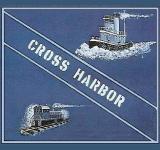 |
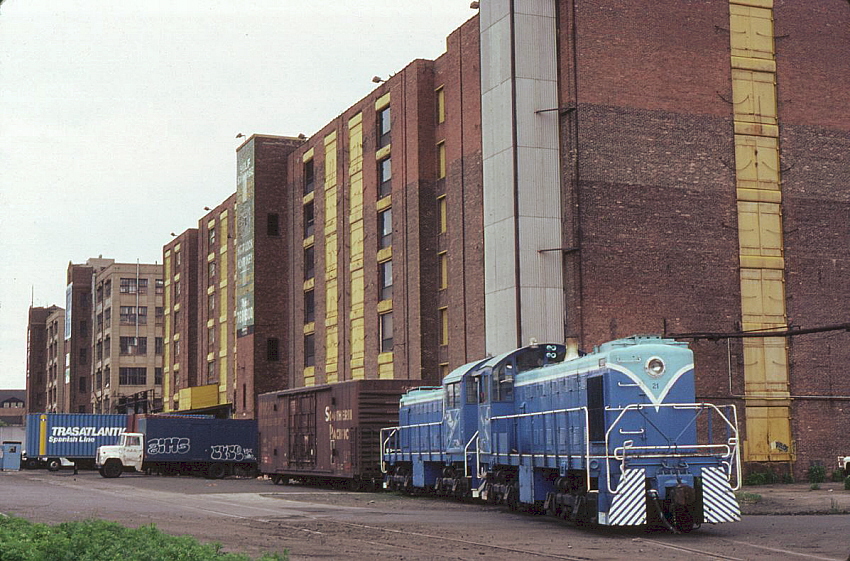
|
updated: |
||
|
|
||
| update summary: | date: | location |
| W. Mangahas "Brooklyn III" and "Cross Harbor I" tug photos added | 19 April 2021 | Marine Equipment |
.
.

.
|
Properties |
|||
|
The
Bogie Experiment |
Special
Moves |
Miscellaneous Data | |
| Locomotive Overview | |||
.
.
The New York Cross Harbor Railroad was organized in the second week of August 1983, when the Brooklyn Eastern District Terminal (BEDT) and New York Dock (NYD) organizations ceased operation the week before.
The New York Cross Harbor Railroad was organized for one sole reason, to continue carfloating operations in New York Harbor. Carfloating operations have been a part of New York Harbor since the 1860's, and Brooklyn itself would see its first carfloat operator, Palmer's Dock, in 1876.
In 1983, the New York Cross Harbor Railroad took control of the properties at Bush Terminal, as well as Atlantic Terminal. The New York Cross Harbor Railroad also acquired all the locomotives and marine equipment (tugboats & carfloats) from each of the predecessor operations (BEDT & NYD), but it would only keep certain pieces of equipment for their operations. Unused marine equipment was sold off, and the undesired remainder of the locomotives were placed on a carfloat, and would be stored at Fulton Terminal before they were sold and / or scrapped.
The New York Cross Harbor Railroad would initially operate carfloat service between Bush Terminal (Sunset Park) Brooklyn, NY and Greenville Yard (Jersey City), NJ as well as between the Atlantic Terminal (Downtown Brooklyn) and Greenville Yard.
The following excerpt is taken from the New York Regional Rail's 2001 filing with the US Securities & Exchange Commissions:
| The Company has historically functioned
as a transfer station for freight onto and from the national railroad system.
Most of the Company's "bridge traffic" (defined below) or "transfer" freight
arrives at its Greenville yard and is destined for points East. The primary
commodities that the Company "transferred from West to East, during 2001
and 2000 were forest products, such as paper and lumber, plastic resins,
and gases, such as propane and freon.
The chief commodities that the Company "transferred" from East to West, during 2001 and 2000 were scrap products, such as scrap metal and recycled paper. For the year ended December 31, 2000, cocoa shipments accounted for approximately 45% of NYCH's revenue and was the only commodity that "originated" from NYCH's facilities. Cocoa arrives at the New York ports from the producing countries and is stored for future deliveries. Beginning in April 2000, the Company changed the focus of its rail operations. The Company began a multi-phase project that included site clearance, paving and lighting to expand and fully utilize the resources at its Greenville Yard. Previously the Company was only utilizing approximately 7 acres, which contain the Company's track, leaving 15-acres of property unused. This project was completed in March 2001 and upon completion, the Company began expanding its terminal facility for transloading, warehousing and distribution activities. Transloading involves the unloading of freight from rail cars onto trucks for delivery or the loading of freight from trucks onto rail cars for shipment. The Company intends to warehouse commodities, expected to be distributed within 30 days from arrival. In March 2001, the Company began to set-up transload areas in its yard and signed a multi-year agreement, with Merco Joint Venture, LLC, for the transload of bio-solids. Although this contract terminated shortly thereafter, the Company was able to sign another multi-year agreement, with Unified Services Group, for the transload of bio-solids in June 2001. In August 2001, the Company began to transport freight under this contract. In December 2001, the Company signed an additional multi-year agreement with Transload Services, L.L.C for the transload, warehouse and distribution of structural steel products. In March 2002, the Company began to receive carloads of steel for distribution. In March 2002, the Company began the transloading and shipment of additional containerized freight. These transload areas allow the Company to utilize its Greenville Yard more productively and engage the Company's trucking subsidiary, JST, in the operations. The Company anticipates it will be able to continue to grow this facility and to duplicate its successes at its yard in Brooklyn. The Company now has four distinct areas of business:
1) Bridge Traffic At both its terminals, the Company receives rail cars, which are loaded onto float barges, and are ferried by tugboat between Greenville Terminal (NJ) and Bush Terminal Yard (NY). a) Westbound Freight: Railcars arrive either from local customers or from the Bay Ridge Junction interchange yard. They are then loaded onto float barges, and are ferried by tugboat to Greenville Terminal where they are sorted for local New Jersey delivery or are interchanged with CSAO for destinations on the national rail network. b) Eastbound Freight. When the railcars arrive at the Greenville Yard from the national rail network they are loaded onto float barges, and are ferried by tugboat to Bush Terminal where they are sorted for local New York delivery or are interchanged with the NYA for destinations in Long Island or the Northeast. . 2) Transload Operations At both its terminals, the Company receives rail cars that are destined for transload operation: . a) Greenville i) Bio-solids. Rail cars arrive at Greenville Terminal and are set aside on holding tracks. Trucks carrying loaded containers from various locations throughout the City of New York arrive at the Greenville facility where the containers are loaded onto the rail cars by means of a forklift. Empty containers are then placed on the trucks for reloading. Once the rail cars are loaded they are interchanged with CSAO for destinations on the national rail network. ii) Steel. Loaded rail cars arrive at Greenville Terminal and are set aside on warehouse tracks. Trucks are loaded with the steel using a crane and commence local delivery. Steel is sometimes warehoused for future delivery. Once the rail cars are emptied they are interchanged with CSAO for their reload destination. iii) Other containerized freight. (1) Empty rail cars. Rail cars with empty containers arrive at Greenville where they are placed on holding tracks. Trucks with loaded containers are unloaded directly onto the rail cars. The empty containers are then placed on the trucks for reloading. Once the rail cars are completely loaded they are interchanged for final shipping. (2) Loaded rail cars. Rail cars with loaded containers arrive at Greenville where they are placed on holding tracks. The loaded containers are placed on empty trucks which then set out for their local deliveries. Once the rail cars are emptied they are interchanged with CSAO for their reload destination. . b) Bush Terminal i) Pipe. Loaded rail cars arrive at Bush Terminal and are set aside on warehouse tracks. Trucks are loaded with the pipe using a crane and commence local delivery. Pipe is sometimes warehoused for future delivery. Once the rail cars are emptied they are interchanged with CSAO for their reload destination. ii) Scrap Metal. Empty rail cars arrive at Bush Terminal where they are placed on holding tracks. Truckloads of scrap metal are unloaded into the waiting rail cars by means of a magnetic crane. Once the rail cars are loaded they are interchanged for final shipping. iii) Lumber. Loaded rail cars arrive at Bush Terminal and are set aside on warehouse tracks. Using a forklift, trucks are loaded with lumber in order to commence local delivery. . 3) Shipside & Dockside The Company can, by means of its float barges, anchor shipside or dockside for receipt or delivery of various types of cargo. If the cargo is destined for local delivery it can then be ferried to the appropriate terminal for offloading or transported to its final destination. During 2001, the Company used the shipside method of the transfer of large electrical transformers and regularly uses the dockside method for cocoa. a) Cocoa- The Company is the "originating" railroad for the majority of the country's supply of Cocoa. Empty rail cars arrive in Greenville where they are loaded onto float barges for ferrying to the Brooklyn docks at Redhook. At Redhook, the Company in conjunction with American Stevedoring and the Port Authority of New York & New Jersey have developed an efficient system whereby the Company's float barges are docked pier-side. Then, using a system of ramps or conveyor belts, the beans are loaded directly from the warehouses. Once loaded they are ferried back to Greenville Terminal and are placed on the national rail network for final destination across the country. During the year ended December 31, 2001, cocoa shipments accounted for 30% of NYCH's revenue. . 4) Local Deliveries At both its Greenville and Bush Terminal facilities the Company receives rail cars destined for its local customers in Brooklyn. Rail cars received in Greenville are transported via float barge to Bush Terminal. From Bush Terminal, all rail cars are delivered directly to the Company's rail served customers.
Current Business (at date of filing: 2001) Since Conrail's operations were acquired by Norfolk Southern and CSX Transportation in June 1999, both NS and CSX have used the Company more frequently to transport freight between New Jersey and the New York/Long Island areas. The Company believes this trend will continue as the Company continues to prove it has a fast and reliable delivery system able to fulfill their customer's needs. As of December 31, 2001, the Company's rail operation had approximately 48 active customers. During the periods listed below the following customers accounted for more than 10% of the Company's revenues from its railroad operations:
The Company's current operating capacity is approximately 2,000 carloads per month. For the month ended February 28, 2002, the Company was transporting approximately 322 carloads per month (a carload refers to one loaded rail car). This is an increase from periods prior to February 28, 2000, when the Company was transporting an average of approximately 290 carloads per month. The Company charges between $250 and $1,250 per carload depending upon the length and weight of the railcar, and the type of commodity being shipped. The Company estimates that depending on the mix, it needs to transport at least 300 carloads per month in order to be marginally profitable.
Operating Property & Equipment The Company's rail equipment, including leased equipment, consists of the following;
The Company has approximately 13 miles of track on the New Jersey and Brooklyn waterfronts. All of the Company's track is operational and in good working order. Float bridges serve as the rail link between the Company's float barges and the Company's land-based rail tracks. Two of the Company's three operational float barges are 40 ft. by 290 ft. and one is 41 ft. by 360 ft. Each float barge contains three rail tracks and can hold between seven and eighteen railcars depending upon the size of the railcars being loaded and the size of the car float used. Diesel-fueled locomotives are used by the Company to switch railcars at its Bush Terminal and Greenville facilities. The Company currently leases two (2) locomotives, on a month-to-month basis, from BDL Enterprises, Inc. Tugboat services are subcontracted from McAllister Marine Towing & Transportation Company on a monthly basis. The Bush Terminal is operated by the Company on a month-to-month permit with New York City. Although this facility is fully operational, it currently operates at less than 10% of its total capacity. The monthly rental of the Bush Terminal is $2,200. (See Note H and Note I of the Financial Statements). The Greenville Yard serves as the primary rail car float facility in New Jersey and connects by rail to the Oak Island freight yard in Newark, New Jersey. The Greenville Yard is situated on a one-mile long, 22.14-acre parcel leased to the Company until 2023 at an annual rental rate of $28,825 per year. The lease agreement with Conrail also transferred all real property associated with the operation of the rail yard to the Company for $1.00. |
|||||||||||||||||||||||||||||||||
. In 2006, the New York Cross Harbor Railroad (in name) ceased operation. Following a change of ownership and administrative personnel, the operation would be renamed New York New Jersey Rail, LLC; and carfloating would continue to be part of New York Harbor.
Now, over a century later; a lot of history is involved. Regardless of the change of name, it is still the last railroad to utilize carfloating operations in New York Harbor!
If you are interested in the in depth history of Offline Terminal / Common Carrier Railroads that make up the predecessor history of the New York Cross Harbor Railroad / New York New Jersey Rail, please read the pages on: Bush Terminal, New York Dock and Brooklyn Eastern District Terminal.
.
New York Cross Harbor Railroad
The New York Cross Harbor Railroad was born "from the ashes" so to say; of the New York Dock and Brooklyn Eastern District Terminal operations. A little back story is necessary at this time to set the stage:
Both the Brooklyn Eastern District Terminal and New York Dock were offline terminal & common carrier railroads operating carfloat service between New Jersey and Brooklyn. Their operations, like that of most of the railroads in the Northeast, had fallen on very hard times the last years of their history due to the advent and increased usage and convenience of containerized truck traffic. As a result, this caused a decrease in Car Load (CL) and Less than Car Load (LCL) railroad freight traffic entering the New York City proper through the New Jersey railyards.
The Bush Terminal Railroad was originally was acquired by New York Dock in 1972 after Bush Terminal filed for bankruptcy. It was at this time that the City of New York took possession of the Bush Terminal property and subsequently leased the operation to New York Dock. New York Dock officially commenced operation on March 11, 1972.
In 1976, the formation of Conrail had a very large impact on these two small offline terminal railroads in Brooklyn. As Conrail was not interested in marine operations, the Brooklyn Eastern District Terminal was subsequently contracted by Conrail to provide the carfloating services for both themselves and New York Dock; from the Greenville Yard in New Jersey to the respective locations in Brooklyn and vice versa. You can read more of the Conrail contract on the BEDT page of this website.
In 1978, New York Dock purchased and merged with Brooklyn Eastern District Terminal. The details of this purchase / merger can also be read on the BEDT page of this website.
In the second week of August 1983; both the New York Dock and Brooklyn Eastern District Terminal officially ceased operations. The BEDT Bulk Flour Terminal (on Kent Avenue between North 8th and North 9th Streets) received its last cars this date, (the BFT was one of the BEDT's largest entities). The NYD however, had ceased operations at their Fulton Terminal prior to this, in early 1982.
NEW YORK DOCK RAILWAY -- ABANDONMENT -- KINGS COUNTY. NY
Decided: July 8, l983
By application filed June 3, 1983, the New York Cross Harbor Railroad Terminal Corp. (NYCH) seeks a certificate of public convenience and necessity under 49 U.S.C. 10901 to operate a terminal railroad in the New York, NY area.
NYCH also seeks (1) an exemption to issue securities; (2) a waiver of filing fees; and (3) a waiver of any public hearing. In addition, NYCH filed a petition on May 3, 1983 seeking waiver of environment and energy data required under 49 C.F.R. 1150.7. In the alternative NYCH seeks an exemption under 49 U.S.C. 10505.
The Brotherhood of Locomotive Engineers (BLE) protests the application. The New York Department of Transportation (NYDOT) has filed comments on the proposal.
Numerous local businesses and governmental bodies have filed letters in support of the proposal.
NYCH seeks authority to conduct a rail and marine service in the Borough of Brooklyn, NY and between Brooklyn, NY and Greenville Yard in Jersey City, NJ. Operations are presently conducted by the New York Dock Railway (NYD). NYD has sought, however, authority to abandon all operations in Docket No. AB-219 (Sub-No. 2), New York Dock Railway Abandonment Kings County.-NY
NYD has agreed to sell assets necessary to conduct
the described operations for $1.5 million. The assets include tracks,
locomotives, a tug, floats, floatbridges, and shop, work and office equipment.
NYD will also lease 4 carfloats to NYCH. NYCH has arranged to lease:
(1) Consolidated Rail Corporation's Greenville yard in Jersey City, NJ
(2) New York City's Brooklyn Army Terminal, Bush Terminal and 65th Street
Yard (when completed); and
(3) the Atlantic Terminal owned by the Port Authority of New York and New
Jersey.
To finance the purchase of New York Dock assets, NYCH has reached an agreement with Northbrook Leasing (Northbrook). Under this agreement, Northbrook will advance $1.5 million to purchase the New York Dock assets. The property will be leased to NYCH for 5 years. At the end of this period NYCH will receive title to the assets from Northbrook for a nominal fee. NYCH has also arranged a loan of $300,000 from the National Bank of North America for working capital. Both agreements will require NYCH to issue promissory notes.
.
New York Regional Rail
In approximately 1996, a new holding company was formed: New York Regional Rail. New York Regional Rail would be the holding company for New York Cross Harbor Railroad; along with JS Transportation.
JS Transportation was a trucking firm based out of Greenville, New Jersey; which mainly transported loose bulk materials. New York Regional Rail brought along many changes in the New York Cross Harbor operation and acquired new customers as well. One of these significant changes was updating the New York Cross Harbor's railroad operation to NORAC qualifications & standards.
In 2006, the New York Cross Harbor Railroad itself would officially become a "Fallen Flag". The new company: Mid Atlantic New England Rail, LLC; based out of West Seneca, NY; purchased and assumed control of New York Cross Harbor Railroad properties and renamed the operation "New York New Jersey Rail, LLC".
Please visit the following page on this website for information of this current entity of this operation: New York New Jersey Rail
.
Throughout its history, the New York Cross Harbor Railroad would come to operate out of several terminals within the Ports of New York & New Jersey.
|
. Brooklyn, NY |
|
| Bush Terminal | Eastern carfloat terminus, service to several spurs and customers. |
| Brooklyn Army Terminal | Used 1983 - 1993, used for larger car moves. |
| 65th Street Yard | Used intermittently, Interchange with LIRR / NY&A. |
| 39th Street Yard | Interchange with South Brooklyn Railway. |
| South Brooklyn Marine Terminal | Used frequently during 1990s, now currently under reconstruction. |
| Atlantic Terminal | Ceased operation 1992. |
| Fulton Terminal | Ceased operation 1982, but remained a location for storage of carfloats. |
| Brooklyn Navy Yard | Serviced a rail car builder, service to this location ceased by 1992. |
|
Jersey City, NJ |
|
| Greenville Yard | Western carfloat terminus - with connection to Conrail Shared Assets
Operations (CSX, NS) Current base of operations |
.
.
.
Bush Terminal was New York Cross Harbor Railroad's most active terminal and operated in conjunction with Greenville Yard in New Jersey. Bush Terminal is located on the east side of Upper New York Harbor in the Sunset Park neighborhood of Brooklyn. Bush Terminal occupies real estate from the bulkhead on the New York Harbor north to 39th Street, east to Second Avenue, south to 65th Street yard, returning west to the Bulkhead and the Bush Terminal railyard is located west of First Avenue between 50th Street and 43 Streets. Several spurs branch out of the yard and run east up several side streets.
The following map, which was part of a Transportation System Management Study is not totally accurate, but serves as a general representation of the Bush Terminal Property layout.

P. M. Goldstein collection
.
.
Paul Strubeck acquired a large scale track schematic of New York Cross Harbor Railroad drawn by "TAB" on April 8, 1988. It reflects trackage both in service (solid line) as well as connected but out of service trackage (broken line) on that date. Clicking on the image below will open a larger image for better legibility.

New York Cross Harbor Track Schematic "TAB drawing" - April 8, 1988
Paul F. Strubeck
collection
added 28 January 2016
.
.
The Enginehouse
The Bush Terminal enginehouse is located at the northwest corner of the yard, off of 43rd Street.
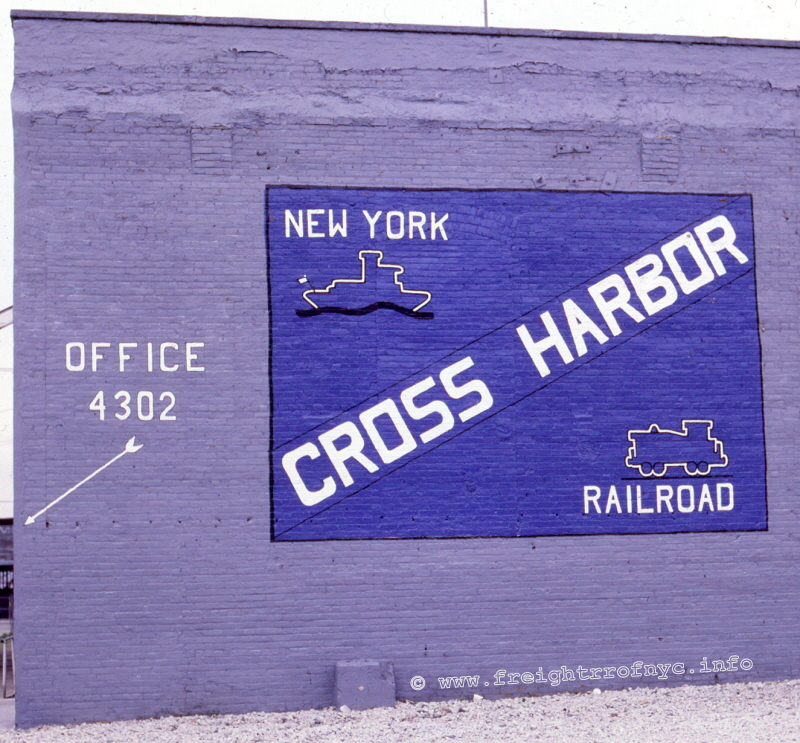
The wall facing First Avenue - unknown date (ca.
1984)
S. Goldstein
photo
P. M. Goldstein
collection
added 11 June 2010
.
.
To get into the north end of the Yard, you must access it through the 43rd Street entrance.
The structure is three tracks wide, of brick construction, and has offices in the rear (north) upstairs portion. To the right (east) of the #3 door, is a small office / workshop.
A couple of tracks did pass along the west wall of the enginehouse to access a service alley running parallel to and between First Avenue and the Bulkhead.
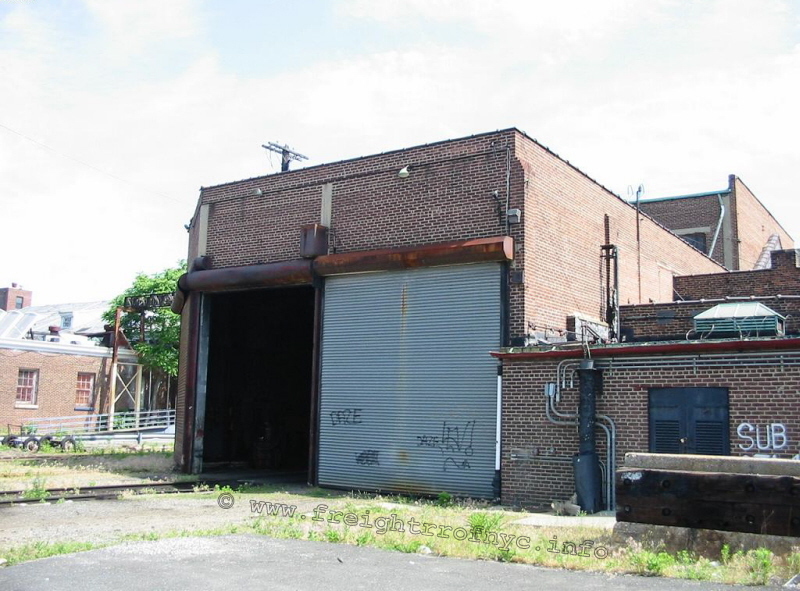
.
.
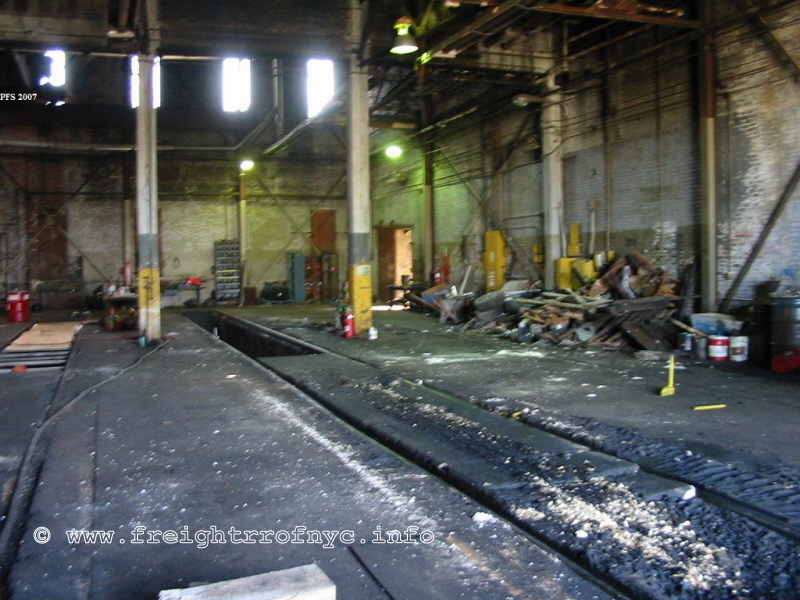
both photos:
Bush Terminal Enginehouse - 2007
P. F. Strubeck
.
.
Currently, this structure is condemned. Plans for this structure are unknown.
A large water tower once towered over the west edge of the railyard bearing the lettering "Bush Terminal". However and unfortunately, this water tower was torn down in 1992.
.
The Yard
|
|
| .
. |
|
|
| .
. |
|
|
| .
. |
|
|
| .
. |
|
|
| .
. |
|
|
| .
. |
|
|
Float Bridges
At the foot of 50th Street and at the southwest corner of the railyard, the Bush Terminal property hosts two carfloat aprons (also commonly referred to as float bridges) that the New York Cross Harbor Railroad utilizes for carfloat service to Greenville, New Jersey: "Bush 1", (the southern float bridge) and "Bush 2" (or the northern float bridge). Both float bridges are located at the foot of 50th Street.. Both float bridges are of pony plate girder construction but are slightly different in construction style: "Bush 1" has tapered girder ends on the outshore end, and "Bush 2" has square ends on the outshore end.
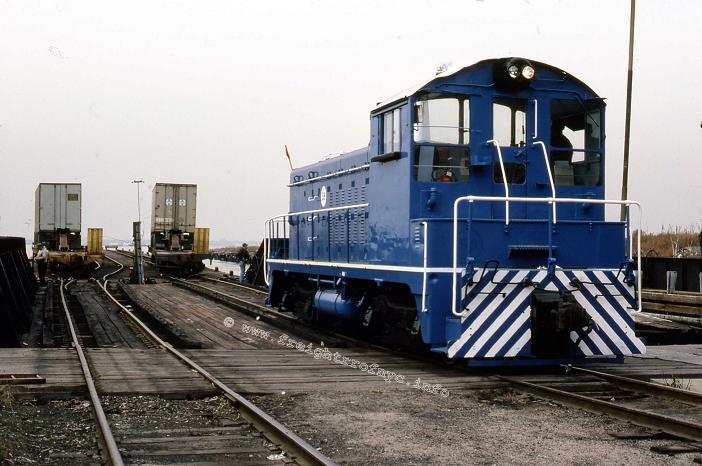
"Bush 1" - November 23, 1983
C. Perelman photo
P. F. Strubeck collection
added 02 May 2012
.
Today only the Bush 2 (the northern float bridge) is in service. Bush 1 is sunk, due to a leaky pontoon:.
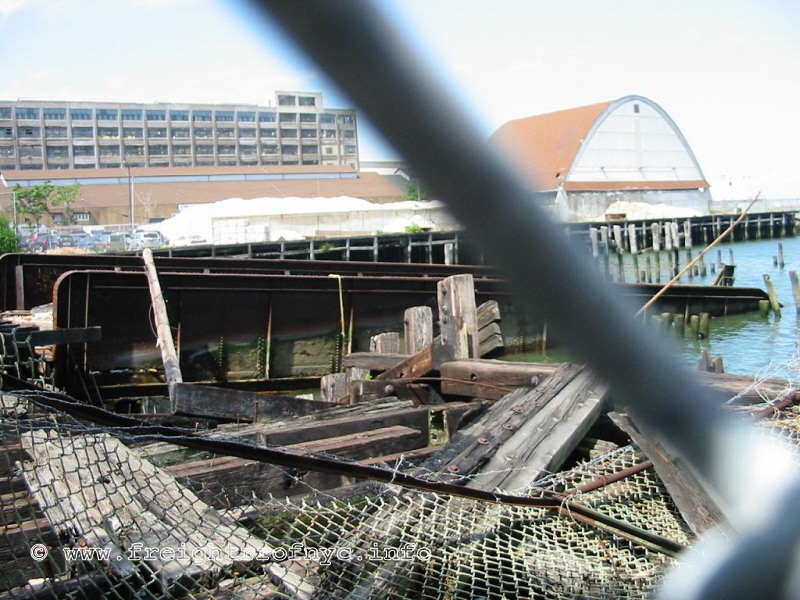
"Bush 1" (sunk) - 2007
P. F. Strubeck photo
.
.
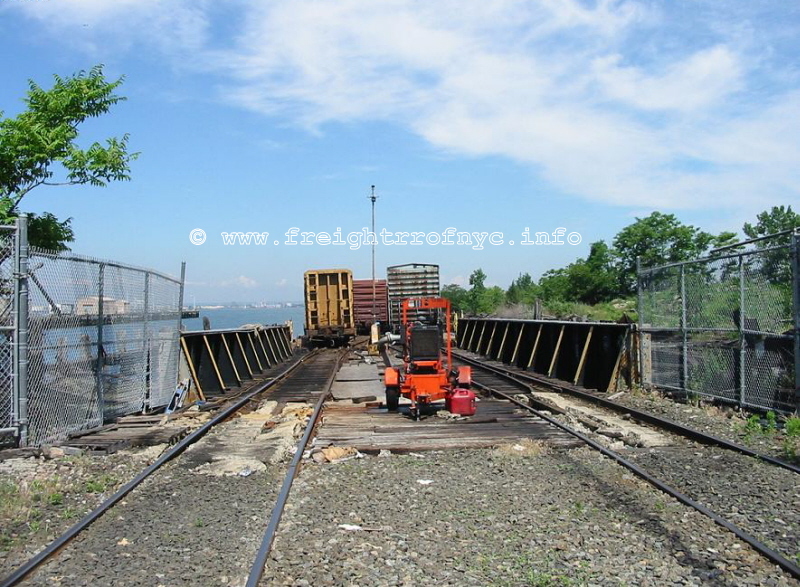
"Bush 2" - 2007
Prior to rebuild.
P. F. Strubeck collection
.
.
In 1998, Bush 2 was re-decked with all new bridge timbers and planking. In the summer of 2007, a long overdue and necessary repair, in the form of a brand new steel pontoon was constructed for Bush 2 by the Great Lakes Shipyard of Cleveland, Ohio. This new pontoon was transported by rail in a disassembled state to the rail yard at Greenville. The pontoon was assembled in the water and floated across to the float bridge in Brooklyn, where it was installed.
Also, in the Fall of 2007 this float bridge would again be re-decked and the trackage comprising of the float bridge approach was rebuilt at this time as well:
|
|
| .
. |
|
|
| .
. |
|
|
| .
. |
|
|
.
.
Interchanges
The New York Cross Harbor Railroad made this location its base of operations, and operated two interchange points at Bush Terminal:
The southern interchange point, with the Long Island Rail Road (and subsequently the New York & Atlantic Railway), is located at the former New York New Haven & Hartford Railroad's 65th Street Yard, accessed via the Bay Ridge Branch. Currently this location is administered to and switched by the New York & Atlantic Railway.
A chapter on the 65th Street Yard can be read below.
The northern interchange point is located at 39th Street and Second Avenue, and is in conjunction with the South Brooklyn Railway, a freight hauling subsidiary of the New York City Transit Authority, and part of the Metropolitan Transportation Authority. More about this location can be read on the South Brooklyn Railway page of this website.
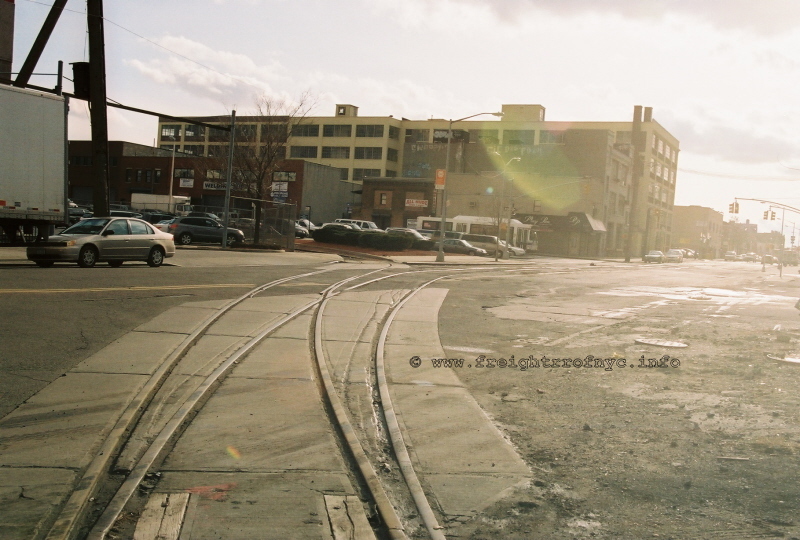
"Bush Junction" on Second Avenue between 37th and 39th
Streets, Brooklyn, NY - January 2010
Left track is South Brooklyn Railway and leads around CostCo Wholesale
Club.
Right tracks is former NYCH / present NYNJ trackage down Second Avenue.
South Brooklyn Railway 39th Street Yard is behind photographer.
Note the flange score marks in the concrete paralleling the NYNJ track. Something
derailed here!
P. M. Goldstein photo
.
A separate chapter on the 39th Street Yard can be read below as well.
.
Street Trackage
What makes Bush Terminal unlike any other; is that the trains still run on trackage and routing as Bush Terminal's trains had done since 1905: right down the middle of public streets and almost every day!
These street tracks are comprised of "girder" rail in the northern portion of trackage (the remaining unrebuilt sections). Girder rail is a special trackage designed for street running, that has a inside guard rail already cast / extruded as part of the rail to protect the flanges of the car wheels, and to prevent derailments. This is the same type of rail to what streetcars and trolleys use to this day. Please see the Glossary for an illustration of this type of rail. In some locations these tracks are still set in the original cobblestone pavers (correctly called "setts") dating back to 1905.
As most of the trackage used by the New York Cross Harbor Railroad and now the New York New Jersey Rail is in the street, it does not take a stretch of imagination to realize the inconveniences encountered with vehicular traffic and rail operations sharing the same space.
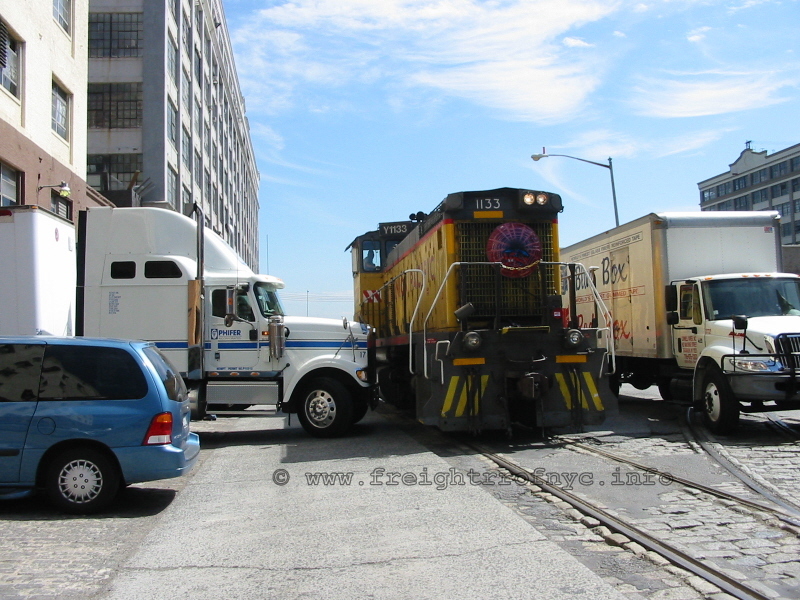
First Avenue & 41st Street - June 11, 2007
Looking north.
P. F. Strubeck photo
.
.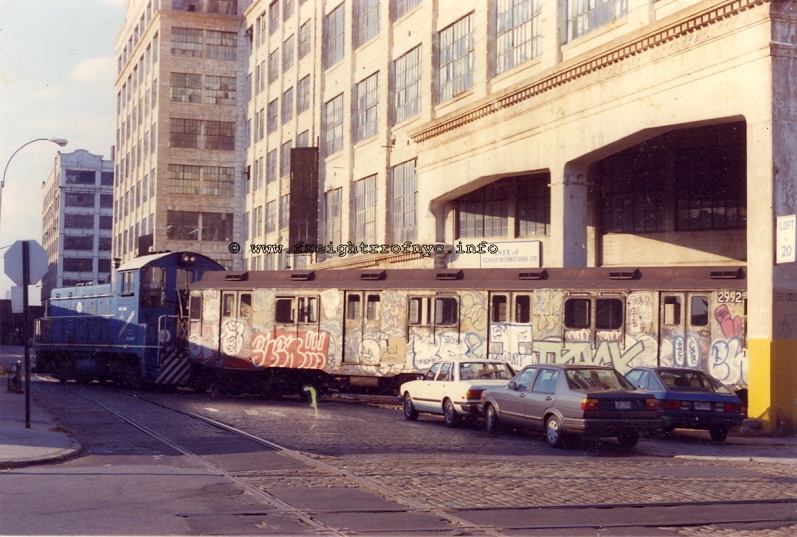
An older photo of the same location at the intersection of Second Avenue
and 41st Street - unknown date
Looking west down 41st Street towards First Avenue from Second Avenue.
#59 is pulling a string of IND R10's to be sent out to Naparano in Newark,
NJ for scrapping.
With the construction of the First Avenue track access into the 39th Street
Yard, this unique trackage
and photogenic curve will no longer be used.
Wayne Koch photo
.
Paul Strubeck took an extensive walking tour of the line, taking images as he walked.
These images show in great detail the street trackage, turnouts and sidings to many of the current and former customers. Due to the quantity of images, they have been placed on their own subpage. A link at the bottom of that page will return you here:
New York Cross Harbor Railroad Street Trackage at Bush Terminal
Customer Master List, by
location
.
Bush Terminal & Brooklyn Army Terminal
|
consignee |
location |
commodity |
time |
notes |
| American Edible Oil | ||||
| American Stevedoring | 39th Street Yard | cocoa beans | 1992? - 2001? | operation later done dockside |
| Atlantic Waste | 50th & First Ave. | garbage | 199_? - 1999? | |
| Balbo Oil | ||||
| Cropsey Metal & Recycling | Bush Terminal Yard | scrap metal | 199_? - 2005? | |
| Davidson Pipe | Bush Terminal Yard | pipe | 1994 - Current? | cars originally went c/o South Brooklyn Railway; now uses Bush Terminal Yard |
| East Peak Trading | unknown | rice | unknown | |
| F. & V. Churillo | ||||
| Federation Warehousing Corp. | ||||
| Franklin Polymers | 47th & Second Ave. | plastic pellets | 198_? - 2007? | company under new ownership |
| Gusseo Manufacturing | ||||
| Hercules Corrugated Box Manufacturing Co. | cardboard boxes | |||
| Interdynamics | shop alley | R134a refrigerant | 198_? - 2006? | |
| Merco Joint Venture | Bush Terminal Yard | bio-solids (sewage sludge) | 3/2001- 6/2001 |
short lived contract, new contract signed with Unified Services |
| Midwood Lumber | 54th & First Ave. | lumber | 199_? | current consignee, originally had own siding, now utilizes yard |
| MVP Warehousing | shop alley | rice | 1994 - 1996 | |
| New York City Transit Authority |
c/o SBK Rwy. @ 39th & Second |
subway cars, track material | 1983 - 2006? | |
| New York Piggyback | Brooklyn Army Terminal | |||
| New York Railcar Corp | Brooklyn Army Terminal | |||
| Plywood Specialties | 40st & First Avenue | lumber / building materials | 198? - 2005? | siding now used by another consignee |
| Quiltex Co. Inc. | ||||
| S & E Building Supply | ||||
| Safety Kleen | Bush Terminal Yard | waste oil | 1993 - ? | |
| Sano-Cup Corp. | ||||
| Thrifty Paper | ||||
| Unified Services | Bush Terminal Yard | bio-solids (sewage sludge) | 6/2001 - 7/2001 | |
| Vesuvio Foods | unknown | unknown | unknown | |
| Yi Pin | Bush Terminal Yard | pre packaged chinese food condiments | former Plywood Specialties | |
|
.
Atlantic Terminal |
||||
| Bowater Paper Co. | ||||
| Dykes Lumber Co. | lumber & building products | |||
| Jakes Products | ||||
| Paul Markesano & Son's | sand, gravel | |||
| John Markesano Trucking | (possibly the "son" in Markesano & Sons) | |||
| Schoenberg Salt Co. | ||||
| Universal Maritime Co. | ||||
|
.
65th Street / Bay Ridge Yard |
||||
| Long Island Rail Road / New York & Atlantic Railway |
freight car interchange | |||
|
.
Brooklyn Navy Yard |
||||
| Mitsui & Co. Inc. | ||||
| Nemco Inc. | ||||
| .
. Greenville, NJ |
||||
| Transload Services | west end of Greenville Yard |
transload, warehouse & structural steel distribution | 12/2001 - 3/2002 |
|
|
.
. Dockside & Direct from Carfloat Customers |
||||
| American Stevedoring | Red Hook Pier 7 & 8 | coffee & cocoa bean importing | 2002-2006 | |
| Domino Sugar | East River, Brooklyn | liquid sugar in tank trailers on flatcars sugar refining |
1989 | one time delivery |
| unknown scrap metal yard | Newtown Creek, Queens | scrap metal loaded into gondolas | 1984? | |
.
In March 2001, the Company began to set-up transload areas in its yard and signed a multi-year agreement, with Merco Joint Venture, LLC, for the transload of bio-solids.
Although this contract terminated shortly thereafter, the Company was able to sign another multi-year agreement, with Unified Services Group, for the transload of bio-solids in June 2001.
In August 2001, the Company began to transport freight under this contract.
In December 2001, the Company signed an additional multi-year agreement with Transload Services, L.L.C for the transload, warehouse and distribution of structural steel products.
In March 2002, the Company began to receive carloads of steel for distribution.
In March 2002, the Company began the transloading and shipment of additional containerized freight. These transload areas allow the Company to utilize its Greenville Yard more productively and engage the Company's trucking subsidiary, JS Trucking, in the operations.
In Depth Customer Descriptions
.
South Brooklyn Railway
The freight subsidiary of the New York City Transit Authority, interchanges with New York Cross Harbor Railroad at the South Brooklyn Railway's 39th Street & 2nd Avenue Yard. See below for more info.
The New York Cross Harbor Railroad used to bring freight cars or subway cars to the 39th Street Yard, at which point the South Brooklyn Railway hauls the item to its respective destination within the transit system.
The majority of freight that was shipped by rail (in most cases subway cars), that was destined for the New York City Transit Authority, came in via the New York Cross Harbor Railroad and their float bridges until circa 1994; when the trackage on Second Avenue and 39th Street a/k/a "Bush Junction" was reconstructed.
Allegedly, the reconstruction of the curve restricted car lengths to around 50', so the average subway car (which is 70' to 80' in length) could not negotiate the curve. Whether this is fact or fiction is not known, but the fact remains that no new subway cars have transversed this trackage into the 39th Street Yard since 1994, but outbound subway cars for scrapping did use Bush Junction until circa 2003.
Track material shipments were unaffected and continued to use the street trackage until circa 2004.
Currently the interchange is unused, as the turnout on First Avenue and 41st Street was welded into the Plywood Specialties position, thereby isolating the 41st Street and Second Avenue routing.
For more information on this railroad and operation please click here: South Brooklyn Railway
Interdynamics
This customer is north of 42nd Street (one block north of the enginehouse), and received R134A refrigerant for distribution.
This customer is no longer in occupancy.

Interdynamics Service Alley - 2007
Looking north from 42nd Street
P. F. Strubeck
photo
added 02 May 2012
.
MVP Warehousing
At one point this customer used to receive car load boxcars of rice. This customer was also located north of the shops. This customer went out of business in 1996.
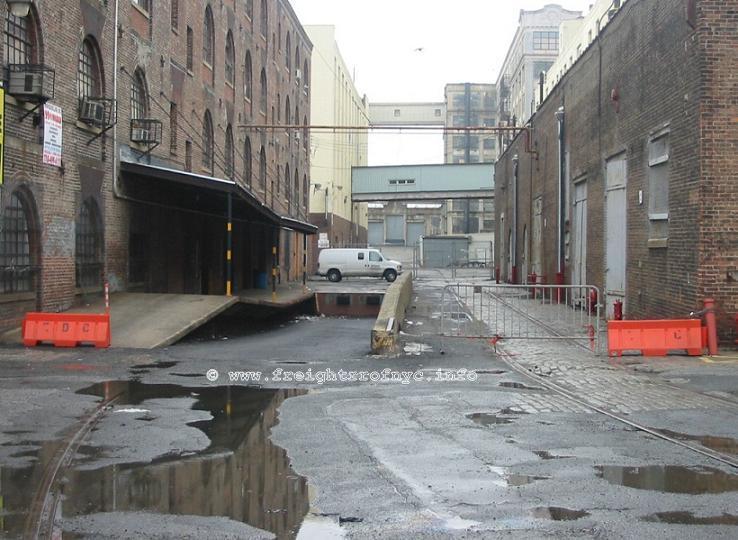
MVP Warehousing siding - 2006
Looking north from 43rd Street
P. F. Strubeck
photo
added 02 May 2012
Plywood Specialties
Located at 40th Street & First Avenue, this customer (no longer in presence) received "centerbeam" bulkhead flatcars loaded with plywood, as well as boxcars of building materials.
Yi Pin Food Specialties
As of circa 2003, a different customer, Yi Pin Food Products; utilizes this siding and receives boxcars of bagged rice. For those of you who are fans of Chinese food (yum!), the little packages of duck sauce, hot mustard and soy sauce come from this distributor!
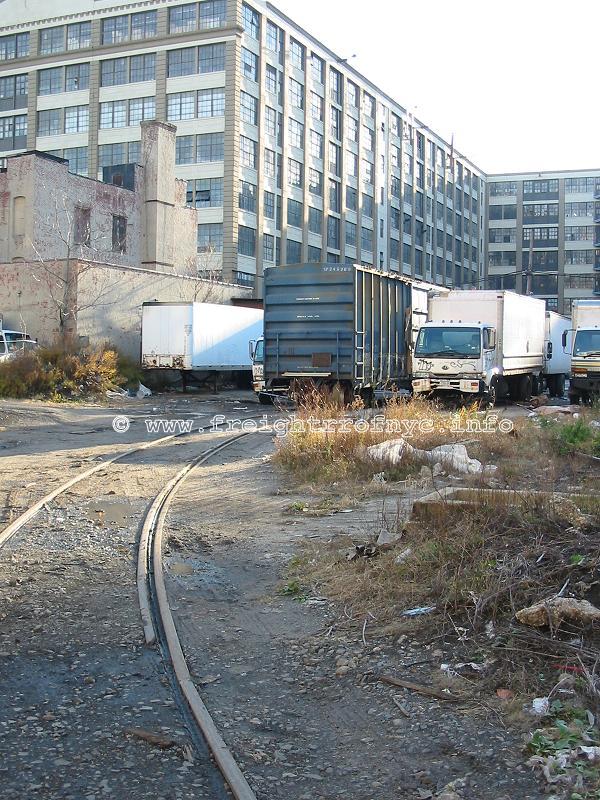
Yi Pin / Plywood Specialties siding at First Avenue
& 40th Street - 2007
P. F. Strubeck photo
.
.
Midwood Lumber
Located at 50th Street & First Avenue. A spur siding was constructed, but was rarely used.
When constructed, this siding it was designed with very sharp radii, and it is difficult for modern length freight cars to negotiate the curve.
East Peak Trading
Received boxcars of rice.
Merco Joint Ventures
Beginning in 1992, New York Cross Harbor Railroad received a new freight consignee, Merco Joint Ventures.
Merco was a third party contractor that removed the sewage sludge from City of New York sewage treatment plants. During the first few weeks of this operation, the semi-solid sludge was loaded in 20' sealed containers in which the New York Cross Harbor Railroad would then load onto their own 89' flat cars. Soon after this however, TTCX 60' flat cars were used.
In 1993, the flat cars would somewhat be replaced by new cars, called "WastePackers". These cars were developed by Johnstown America Freight Car Company. WastePackers were a two unit articulated spine car, in which three 20' containers can be loaded for each half of the car, thus increasing productivity.
In transition between the TTCX flat cars and the "WastePackers", articulated "ULTRA" stack cars from Epic were used. These ULTRA cars were very similar in design to WastePacker cars. Merco's WastePacker cars used "MERX" reporting marks, and the containers themselves bore "MJVU" reporting marks.
The loading operation would eventually be moved to Greenville circa 1998, and operated until 2001 at which time the City of New York canceled their contract with Merco. At this time, East Carbon Development Corporation Environmental a/k/a "ECDC Environmental" operated the contract until around 2006 (presumably to finish out the contract). At this same time, the majority of the MERX cars went to ECDC.
New York Cross Harbor would transport the full containers from Brooklyn to Greenville. The cars would be loaded in Bush Terminal, floated to Greenville and then interchanged with Conrail. Only five of the articulated cars could fit on the 290' floats and seven cars on the 360' floats.
These loads ultimately wound up in Texas, at the Sierra Blanca Sludge Ranch where it would be spread out as fertilizer.
Atlantic Waste
At 51st Street & First Avenue: there was a waste disposal firm located here. This location is of note, as the cars ran between two buildings located to either side of a sharp curve with extremely limited clearances.
This customer employed the use of a fleet of 60' ECOX boxcars. Service to this customer ended in the late 1990's.
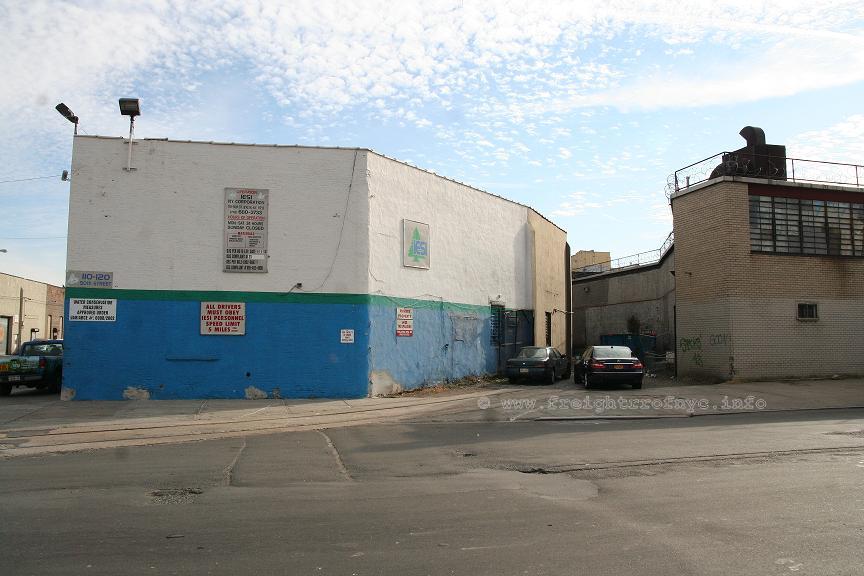
Atlantic Waste - 50th Street & First Avenue - January
2012
(First Avenue in foreground)
P. F. Strubeck
photo
added 02 May 2012
.
..
Franklin Polymers
Located on 47th Street and Second Avenue, this track would cut through the corner of the junk yard on the corner of 47th Street. The track would then head east and cross Second Avenue and enter into a building.
This customer received plastic pellets for injection molding, and it is believed this firms' primary product was plastic bags.
Direct service to this customer ended on an as yet unknown date, and this customer would then draw off its load within the Bush Terminal Yard.
.
Safety Kleen
Safety Kleen had a loading and transfer facility at Bush terminal Yard. To call this a facility would be an overstatement because it was more of a vertical standpipe with a quick / connect hose fitting for loading tankcars with waste oil.
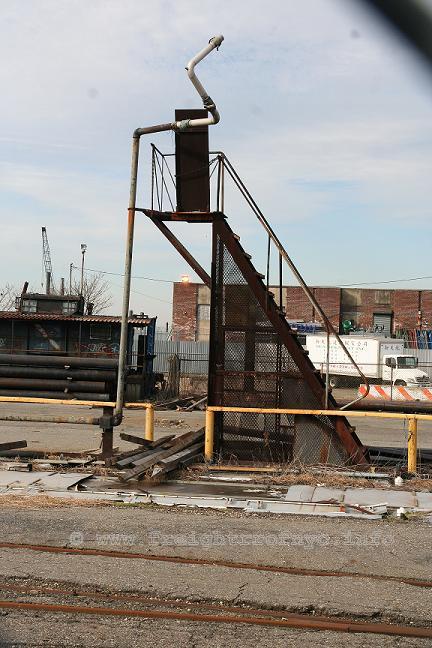
Safety Kleen loading pipe & platform - January
2012
P. F. Strubeck photo
added 02 May 2012
.
.
Davidson Pipe
Davidson Pipe would receive gondolas of pipe via New York Cross Harbor Railroad which would place the cars in the South Brooklyn Railway's 39th Street Yard (between First & Second Avenues). Then, the South Brooklyn Railway would move the gondolas from their 39th Street Yard into Davidson's Pipe Yard located across Second Avenue between Second & Third Avenues.
In 1994, Davidson Pipe downsized and sold this property to Costco, the wholesale club. Davidson would continue to receive gondolas and bulkhead flatcars of pipe, but they would now be unloaded within the Bush Terminal Yard.
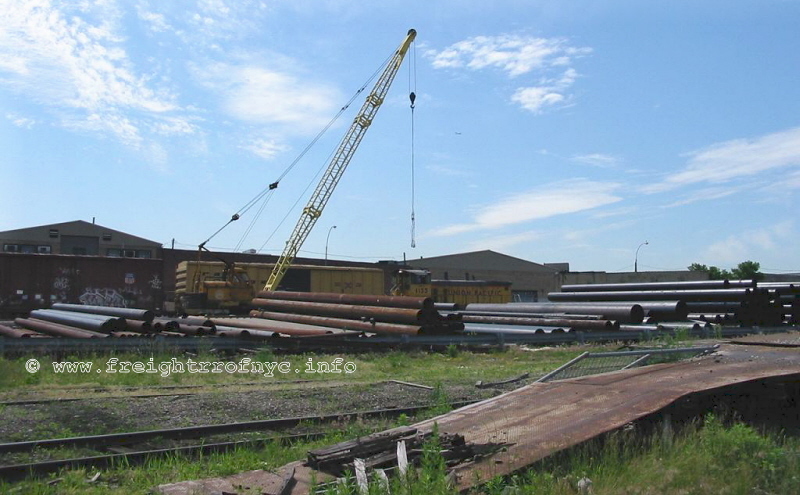
Bush Terminal Yard - Davidson Pipe Area - 2007
P. F. Strubeck photo
Various Customers in Bush Terminal Yard
In the main yard, there are customers who receive cars at this location, including Davidson Pipe, Midwood Lumber, Franklin Polymers and Cropsey Metals. Also located in the northeastern end of the yard, is a paved ramp which was used to unload subway cars that arrived on flatcar for the New York City Transit Authority.
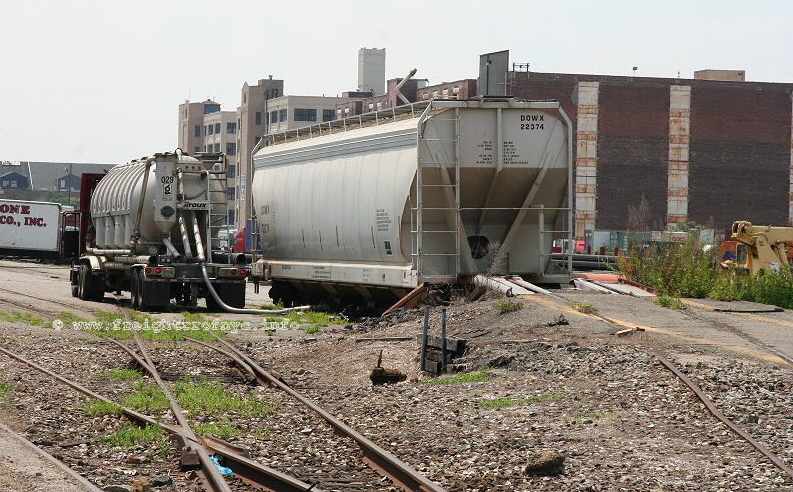
Bulk plastic pellet transfer at Bush Terminal Yard,
Brooklyn, NY - July 28, 2009
Looking south. Note the subway car unloading ramp leading up to end of covered
hopper car.
P. F. Strubeck photo
.
Brooklyn Army
Terminal & the BAT Float Bridge
.
The Brooklyn Army Terminal would see intermittent operation from 1983 through 1992(?).
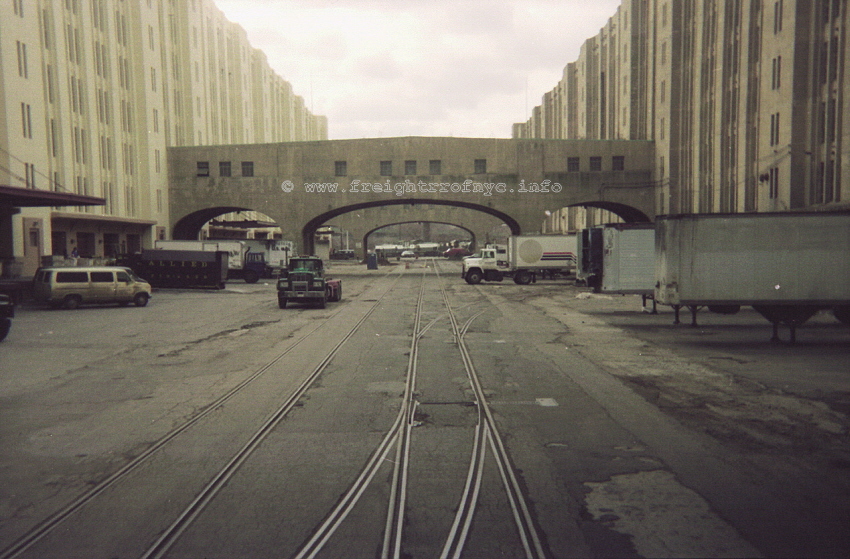
Brooklyn Army Terminal from the cab of NYCH #21 - January
1990
(LIRR locomotives picking up Valley RR #1647 in
background)
M. DeLuca photo
P. M. Goldstein
collection
added 01 May 2012
.
In 1981, a portion of the yard was reconstructed by New York Dock to include the installation of a pontoon type float bridge in the northwest corner of the yard.
It had been stated that this float bridge was relocated to the Brooklyn Army Terminal (adjoining the north edge to the LIRR Bay Ridge Yard) by New York Dock Railway to ease congestion of Bush Terminal, and to avoid the sharp curves approaching the Bush Terminal float bridges, and be be able to the handle railcars of longer length which were gaining use by the Class 1 railroads.
This however is easily disproved by the fact the New York Cross Harbor (and then its successor: New York New Jersey Rail), continued to receive modern sized freight cars without difficulty at "Bush 2" bridge right up until 2012.
The previous information is also invalidated, as research reflects that this float bridge was in fact installed to allow New York Dock (and henceforth; the New York Cross Harbor Railroad after August 1983) to continue carfloat service while the New York City Department of Transportation (NYCDOT) reconstructed First Avenue between 58th and 39th Streets.
Documents and schematics of transportation studies obtained by Philip M. Goldstein in 2008, both independently of as well as from Tom Flagg; reflect the actual intention of this float bridge's installation was the fact that during the reconstruction of First Avenue, the Brooklyn Army Terminal and customers south of the New York Cross Harbor Railroad's float bridges at 50th Street, would be isolated while the street trackage was under reconstruction..
While the following blueprint predates the organization of the New York Cross Harbor Railroad, it bears out the reason for installation of the Brooklyn Army Terminal float bridge: "RECONSTRUCTION OF FIRST (1st) AVE."
Tom Flagg generously furnished the following copy of the New York City Department of Transportation blueprint pertaining to this temporary transfer bridge installation, of which I reproduced the pertinent details of the image here. I omitted general notes to contractor, drainage piping, spiking arrangements, and cross sections to save on image size. Click on the image below to see a large scale hi resolution image. Use the back arrow on your browser to bring you back here.

City of New York, Department of Transportation - Bureau of Highway
Operations
"Reconstruction of First Avenue from 58th Street to 39th Street - Borough
of Brooklyn"
"Temporary Transfer Bridge & Connection at Brooklyn Army Terminal"
(no date - ca. 1980)
courtesy of T. Flagg
.
.
The pontoon float bridge as installed at the Brooklyn Army Terminal, was transplanted from the Erie Railroad 's 28th Street Freight Station on the west side of Manhattan:
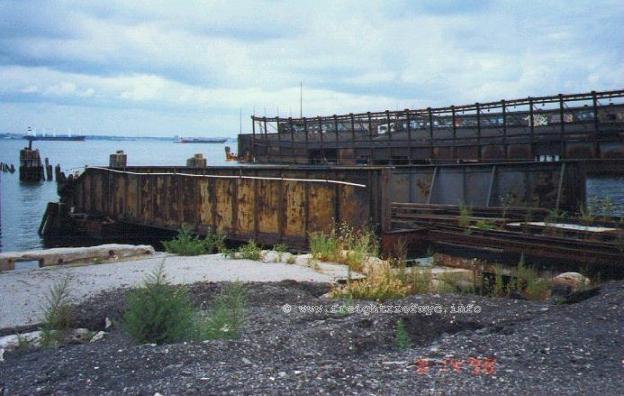
Brooklyn Army Terminal Float Bridge (ex-Erie West 28th Street
Terminal Float Bridge) - August 14, 1998
Looking west-northwest.
John McCluskey photo
via P. F. Strubeck
collection
added 05 May 2009
.
.
The New York Cross Harbor Railroad would continue to use the float bridge through 1996, at which time the New York Cross Harbor Railroad (successor to the New York Dock Railway) determined to be sufficiently deteriorated and not financially feasible to rebuild or replace.
This float bridge still remains at this location, however it has pulled away from the bulkhead anchors and "appears" half sunk:
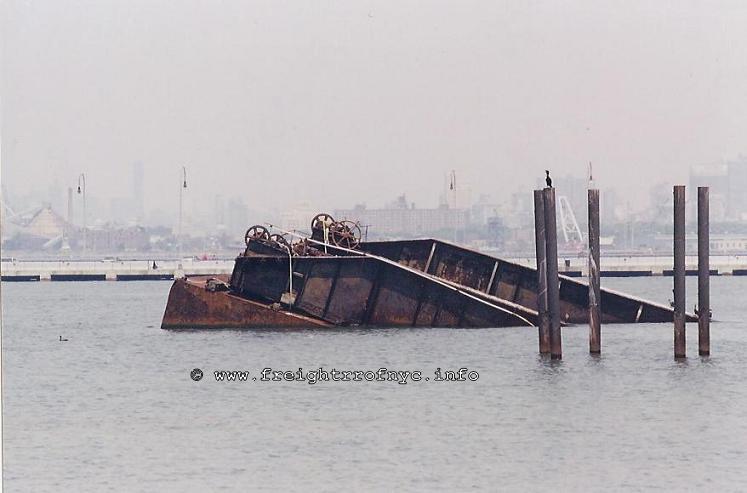
West 28th Street Pony Plate Girder Float Bridge at Brooklyn Army Terminal
- July 6, 2006
photo by author
added 05 May 2009
.
The inner end (land side) is underwater which does not float as the outer end does. As the pontoon was presumably still watertight, that end still appeared to float. Usually, it is the pontoon that usually leaks from age, and the outer end sinks.
But considering that by 2021, this float bridge remains in this position, and did not appear to move or shift during the extremely high storm surge of Hurricane Sandy in 2012, it is now believed the entire float bridge is actually resting on silt, and the pontoon no longer buoyant.While operations at this yard would simplify interchange with the Long Island Rail Road, and subsequently the New York & Atlantic Railway, operations at this location would never reach their full potential. Any freight traffic that would remain at this location, would be those freight cars for interchange between New York Cross Harbor Railroad with New York & Atlantic Railway.
Kindly refer to the New York New Jersey Rail page of this website for operations at this location after 2006.
.
The 65th Street Yard is located at the foot of 65th Street and Second Avenue, just south of and adjacent to the Brooklyn Army Terminal.
The 65th Street Yard, also known as the Bay Ridge Yard; was originally and formerly operated by the New York, New Haven & Hartford Railroad, in conjunction with the Long Island Rail Road (Bay Ridge Division). The 65th Street Yard was once home to four electrically powered cable suspended float bridges. Upon the formation of Penn Central, to gain the approval of the Interstate Commerce Commission; Penn Central was required to take over the freight and passenger operations of the now bankrupt New York New Haven & Hartford RR. This took place on December 31, 1968.
With the 65th Street property taken over by the Penn Central Railroad; and in their efforts to reduce unnecessary duplication of effort or discharge of unprofitable operations (throughout the operations of the former Pennsylvania, New York Central or New York, New Haven & Hartford Railroad operations), the 65th Street Yard was closed and whatever minimal rail traffic rerouted to the north. In 1970, the four transfer bridges were dismantled and the yard saw little use now being at the extreme southern end of Long Island Rail Road.
With the subsequent financial failure of Penn Central beginning in 1970 and throught to the very end; Conrail was formed by the US Government to now bail out the failed Penn Central, which took place on April 1, 1976.
To get to the 65th Street Yard and interchange, the New York Cross Harbor Railroad had to maneuver through the Brooklyn Army Terminal, (see above chapter) of which the trackage runs down the middle of First Avenue to the Bush Terminal Yard and the float bridges at 50th Street.
The 65th Street Yard was never actually owned or operated by the New York Cross Harbor Railroad, but in fact this location is under the control of the Long Island Rail Road and the New York & Atlantic Railway, (being the contracted freight carrier for the Long Island Rail Road).
While it never came to fruition, the New York Cross Harbor Railroad
once planned to relocate its base of operations to the 65th Street Yard,
and thus a brand new pair of cable suspended float bridges were built at this
location in 1999, (ironically on the site of the now demolished four transfer bridges
"Abie", "Benny", "Charlie" and "Davey" of the New York, New Haven & Hartford Railroad.)
The construction of these two new transfer bridges was contracted out by the New York City Economic Development
Corporation. While the NYCEDC is commonly (but erroneously) thought of
as a city government entity, it in actually is a not-for-profit
organization that operates through annual contracts with the City of
New York; and its purpose is to rehabilitate and reconstruct
deteriorating city properties, and thereby either selling them or
leasing them as necessity and location warrant, to local businesses and industries to keep the location economically viable.
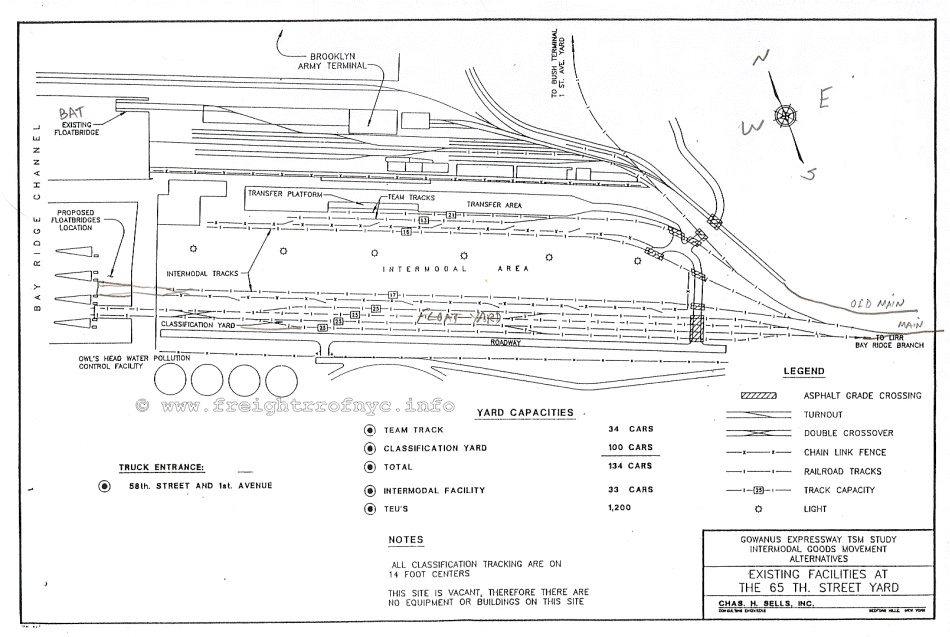
Brooklyn Army Terminal Float Bridge (& 65th Street
Yard & proposed Float Bridges)
P. M. Goldstein collection
.
.
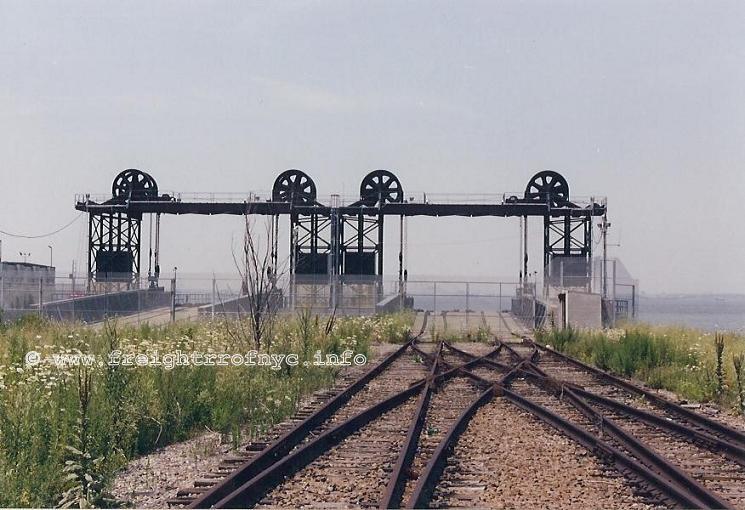
65th Street Yard Float Bridges - July 2006
Looking west.
P. M. Goldstein photo
.
.
Even after their completion; these transfer bridges would sit unused until 2012, when the successor to the New York Cross Harbor Railroad; the New York New Jersey Rail would activate operations at this location.
These transfer bridges also had the distinction of being the first new transfer bridges constructed in New York Harbor in close to a century! (Footnote: a distinction to be given up with the NYNJ Rail's construction and activation of a new overhead supported hydraulically operated transfer bridge in Greenville, NJ commencing 2017).
Kindly refer to the New York New Jersey Rail page of this website for operations at this location after 2006.
.
.
The 39th Street Yard is a property at the northern most end of Bush Terminal. This yard is located between First & Second Avenues, and between 39th Street and 37th Streets.
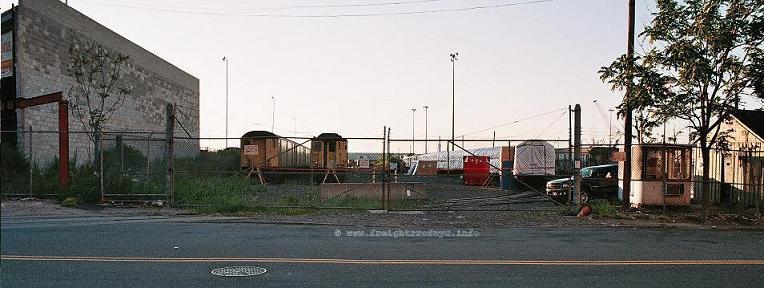
South Brooklyn Railway 39th Street Yard - September
2007
Looking west.
P. F. Strubeck photo
.
.
The 39th Street Yard is the interchange location for New York Cross Harbor Railroad / New York New Jersey Rail and the South Brooklyn Railway. This location is also known as Bush Junction, a name that dates back to early Bush Terminal Railroad operations.
The New York Cross Harbor Railroad transported materials much as ties, rail and other railroad related supplies to this yard, for transfer to the New York City Transit Authority. The New York Cross Harbor Railroad also once hauled scrap subway cars from this location for loading on a carfloat for transportation to a scrapper located in New Jersey, as well as placed new / rebuilt subway cars just arriving from the mainland US, for transfer to the New York City Transit Authority.
As stated, the 39th Street Yard was rebuilt and this reconstruction eliminated the old interchange switch on 2nd Avenue, and now only cars 50 feet and under can be moved here via New York Cross Harbor Railroad.
In 2003, the New York City Economic Development Corporation, in conjunction with the Port Authority of New York & New Jersey put forth a proposal to improve the rail access of the 39th Street Yard and to develop the property north of that yard. One of the proposals contained an automobile loading / unloading facility.
.
South Brooklyn
Marine Terminal
..
The piers west of the 39th Street Yard are known as the South Brooklyn Marine Terminal.
Strangely, rail service to this pier was not provided by the South Brooklyn Railway as one would expect, but by the New York Cross Harbor Railroad which would have to pass through the 39th Street Yard of the South Brooklyn Railroad to enter the South Brooklyn Marine Terminal. By the way, the South Brooklyn Marine Terminal is not affiliated with the South Brooklyn Railway.
It is also now understood that the 39th Street Yard is no longer associated with the South Brooklyn Railway / New York City Transit Authority / Metropolitan Transportation Authority and belongs to the South Brooklyn Marine Terminal.
While it appears the South Brooklyn Railway will still have access via the 39th Street route (around the Costco property), the yard will be serviced by New York New Jersey Rail via a new track access located on First Avenue & 39th Street (see 2007 proposal below).
The following is an excerpt located in the New York State Department of Transportation non-NYSDOT Economic Recovery Act / Tiger pre-application online archives. This "pre-application" was submitted by the New York City Economic Development Corporation.
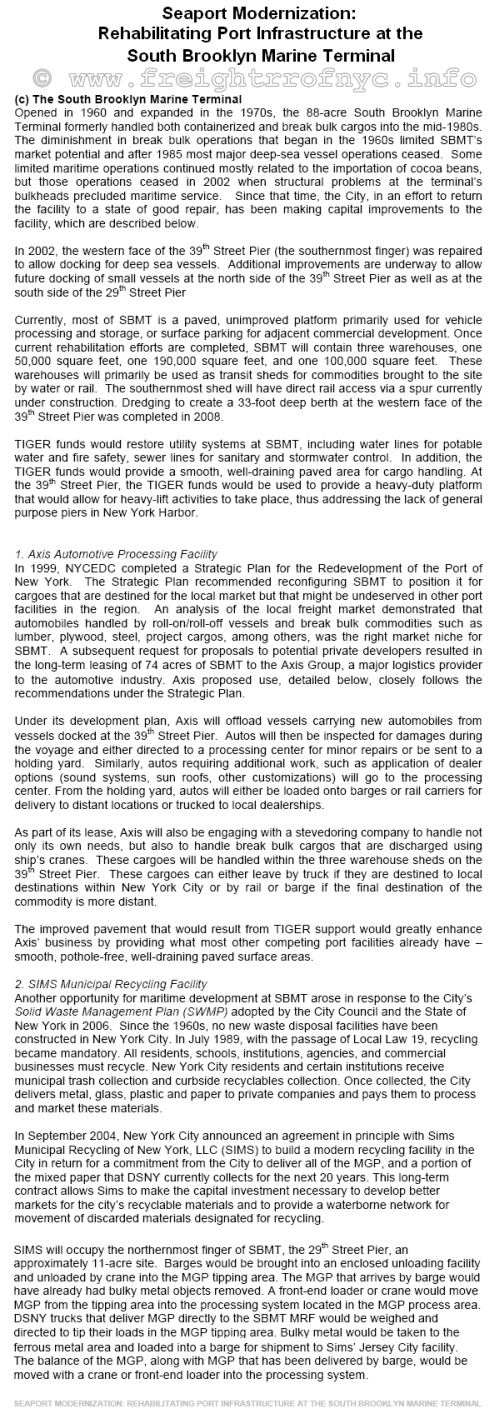
.
.
2003 Proposal

.
The current property proposals and plans for trackage (which are presently [2011] under construction) can be viewed on the New York New Jersey Rail page of this website.
.
.
.American Stevedoring
American Stevedoring received raw cocoa beans via ship and transferred the product to freight cars, which were loaded in the South Brooklyn Marine Terminal (which is located west of the South Brooklyn Railway Yard at Second Avenue & 39th Street).
American Stevedoring would load the hopper cars with a conveyor, thus causing the carfloat to list very badly on occasion. Often, the cocoa beans were pre-bagged, and loaded directly into boxcars. Bagged cocoa loading used to take place at the 39th Street Yard. Deep sea vessels used the berth at the South Brooklyn Marine Terminal until 2002, when structural issues precluded the use of the bulkhead at this location and prevented large vessels from mooring there.
American Stevedoring moved their operation to the Red Hook Container Terminal. Here, cocoa would be transferred directly from deep sea vessels to boxcars which were loaded on a carfloat. (Modern day lighterage service!)
In January 2006, a carfloat was tied up at this pier with loaded hoppers, when the carfloat developed a leak and consequently sunk, taking the hopper cars with it. Thus three or so hoppers were seen floating in the East River for a few days:
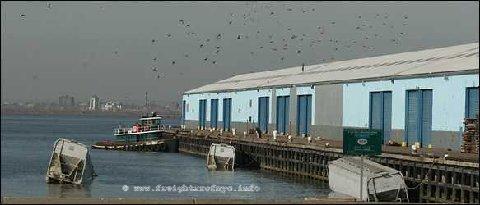
Bobbing for cocoa - January 2006
Red Hook Marine Terminal.
Looking west.
unknown photographer
New York Times photo
.
.
The cocoa unloading operation has since been moved out of New York State to Philadelphia, PA; and this dockside work is no longer done.
.
Domino Sugar
Another customer that received dedicated carfloat service was Domino Sugar on the East River by the Williamsburg Bridge. However, this dedicated carfloat service operation only took place two or three time before service was discontinued.
Domino Sugar was the successor to American Sugar Refining which in turn was known previously as Havemeyer & Elder. Prior to New York Cross Harbor Railroad service, Domino (and it predecessors) would be stalwart customers of the Brooklyn Eastern District Terminal.
During New York Cross Harbor Railroad service, Domino Sugar would receive carfloats with Trailer On Flat Car (TOFC) cars onboard the carfloat, that held tank trailers of liquid sugar.
.
.
The Atlantic Terminal, located in the Atlantic Basin, was also property that was formerly New York Dock.
The Atlantic Basin is located north of Bush Terminal, right off of Ferris Street. Atlantic Terminal serviced a series of public Team Tracks as well as some customers.
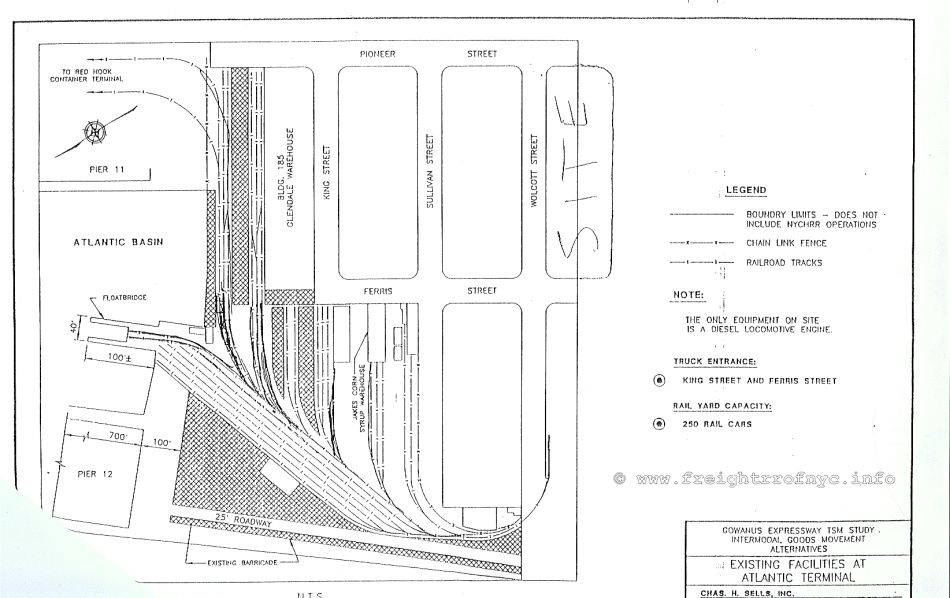
P. M. Goldstein
collection
.
.
Those customers utilizing the Atlantic Terminal received cars such as tank cars of corn syrup, as well as covered hoppers of salt & sugar.
Service at the Atlantic Terminal ended in 1992, but remained unchanged for many years. Within the last 10 years however, the location was reconstructed as a passenger ship terminal, the float bridge (a pony plate girder) was removed in approximately 2005 and its disposition is unknown. Nothing remains of the railroad operation there:
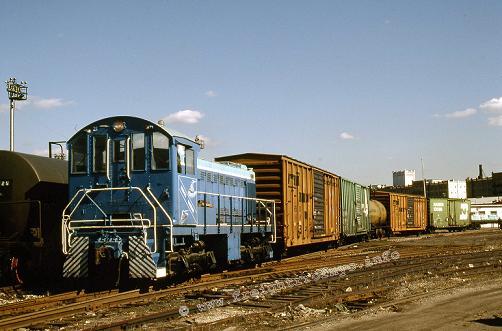
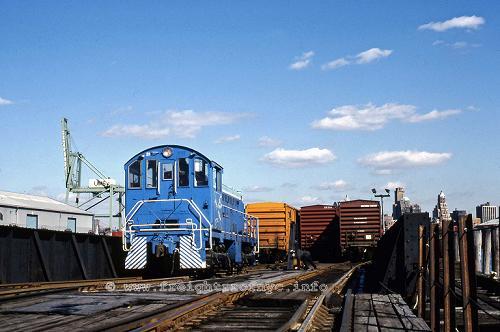
Atlantic Terminal - February 28, 1990
Looking north at #21 switching in the Atlantic Terminal and on the float
bridge.
Carl G. Perelman photos
.
.
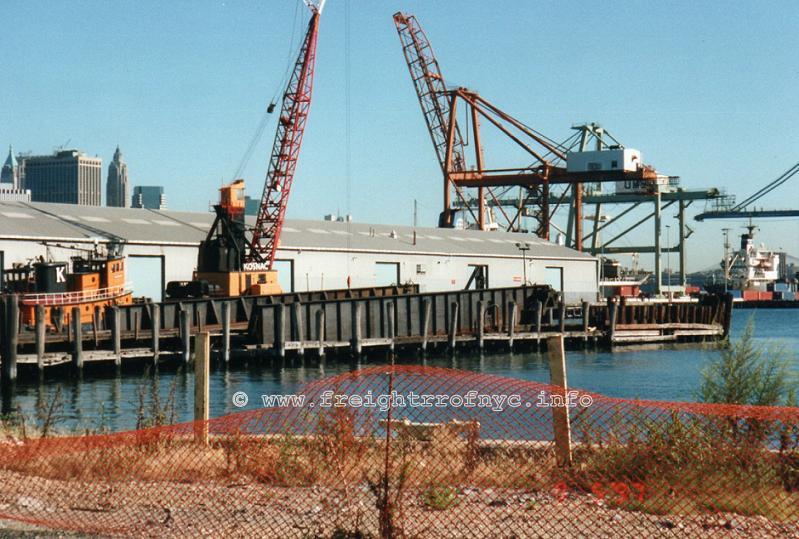
Atlantic Terminal - 1997
Looking north-northwest at the Atlantic Terminal float bridge.
John McCluskey photo
.
.
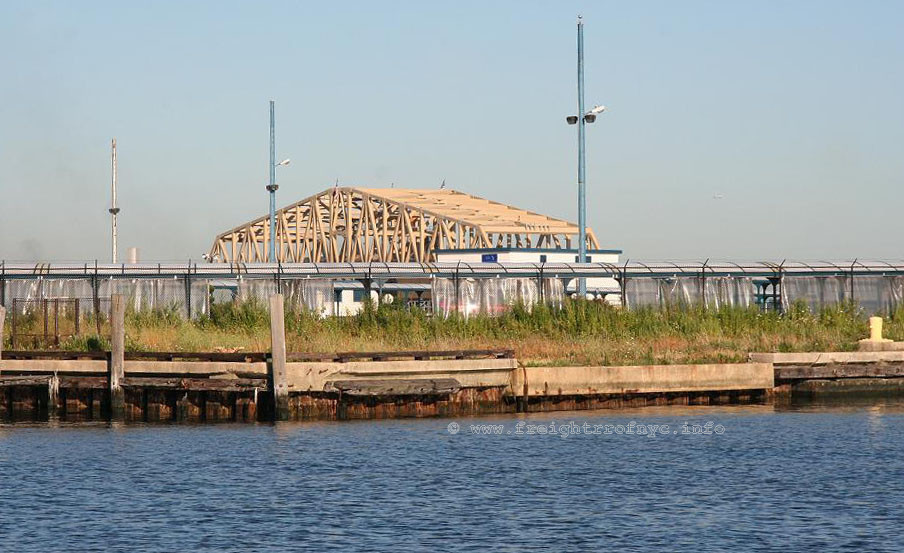 .
.
Atlantic Terminal - 2010
Looking southwest at the former Atlantic Terminal float bridge bulkhead.
Note the "new" Willis Avenue swingbridge in background.
P. F. Strubeck photo
added 02 May
2012
.
.
Fulton Terminal was never actually a New York Cross Harbor Railroad owned or operated piece of property, but the Fulton Terminal was a former New York Dock property.
The Fulton Terminal comprised of an enginehouse, a small yard and two pontoon float bridges.
Fulton Terminal was the location where New York Cross Harbor Railroad stored their tugboats for a period of time, and also where the "Roster on a Barge" (excess locomotive units) was stored.
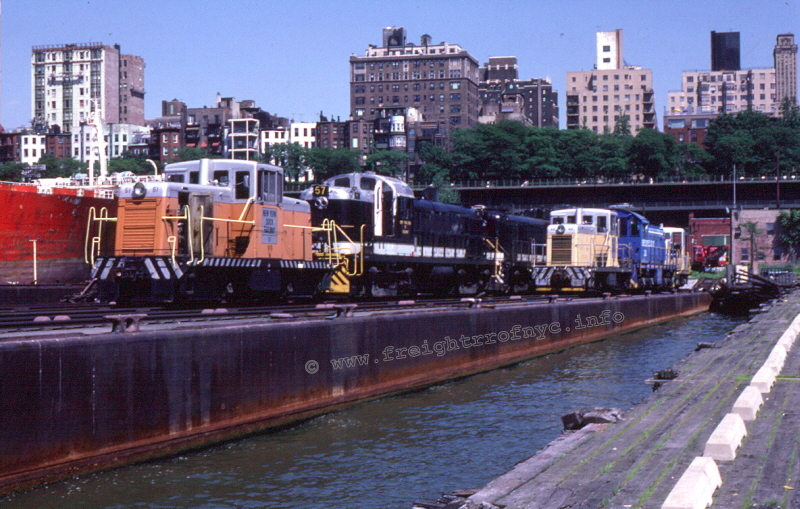
"Roster On A Barge"
Fulton Terminal, Brooklyn, NY - June 21, 1984
unknown photographer
P. M. Goldstein collection
.
.
Today Fulton Terminal remains in an abandoned / derelict state but portion of the site are under reconstruction.
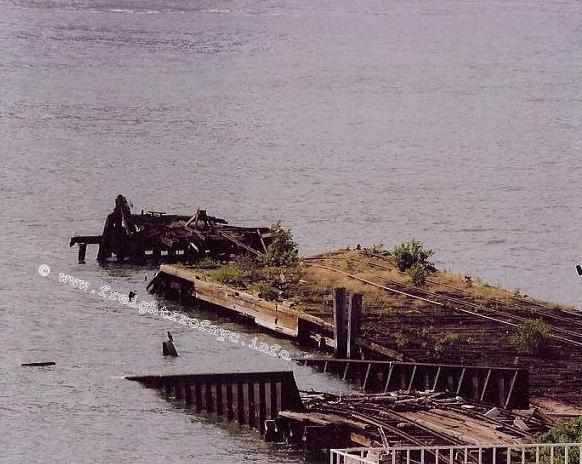
Fulton Terminal Pier Yard and south float bridge -
August 2006
Looking west-northwest.
P. M. Goldstein photo
.
.
As of June 1, 2010; the pier has almost totally collapsed.
.
Another location serviced by the New York Cross Harbor Railroad was the New York Naval Shipyard a/k/a the "Brooklyn Navy Yard".
Located here is a float bridge, and at one point a massive yard / track structure. This location was formally serviced by the Brooklyn Eastern District Terminal from 1941 through ca. 1983. The Navy Yard had just a single carfloat apron, and an interesting one at that.
This float bridge was of the contained apron type, also known as a "French" style; and was an electrically powered overhead suspension bridge. Later on, it was converted to a pontoon float bridge in 1977 but the overhead gantry was left standing.
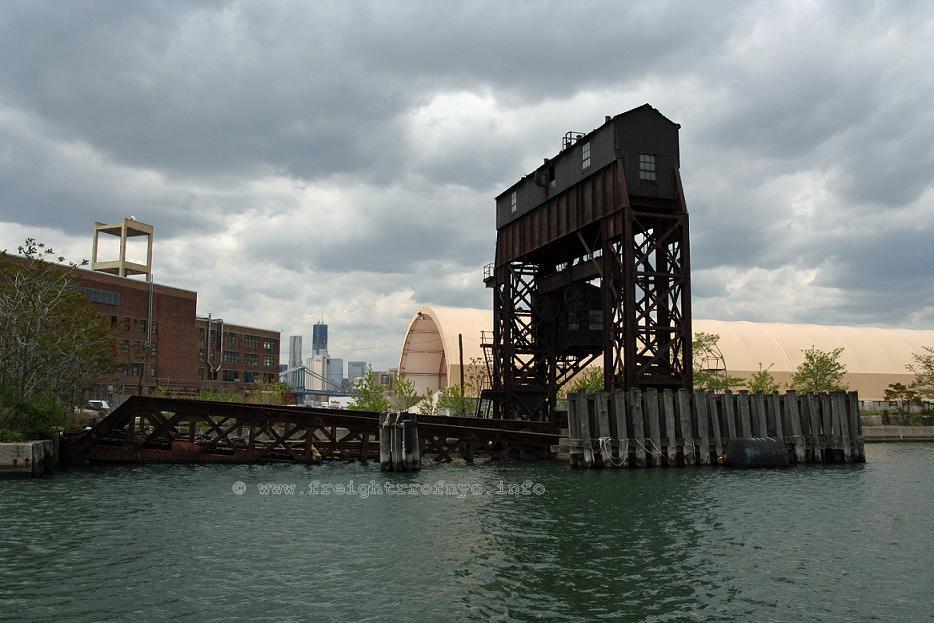
Brooklyn Navy Yard float bridge - April 28, 2012
P. F. Strubeck photo
added 02 May 2012
.
New York Cross Harbor Railroad received a contract to operate in the Brooklyn Navy Yard in the late 1980's, delivering cars to a subway / electric multiple unit car assembler (rebuilder?): NemCo (believed to stand for NorthEast Motorcar Co). This customer was switched once a week. Service ended by 1992 and once the contract ended, so did service to this facility.
Today the float bridge apron and gantry is still intact, but most of the trackage is gone.
.
The railyard at Greenville, NJ, is located in Jersey City, New Jersey, and is the westernmost point of interchange of the New York Cross Harbor Railroad / New York New Jersey Rail. It is currently the base of operations and house a modest trailer which is used as offices for management personnel.
Greenville Yard, including the float bridges; was originally constructed by the Pennsylvania Railroad in 1904 when the PRR outgrew it's Harsimus Cove Yard (somewhat north on the New Jersey shoreline). In it's heyday, this yard was huge. But perhaps what is most interesting is that Greenville Yard rests atop a man-made peninsula.
The original Greenville float bridges and support structures were made of all wood, but following a massive fire in 1931; they were rebuilt in steel to prevent a repeat of the conflagration. Greenville Yard now featured six pony plate girder electrically powered cable suspension float bridges, numbered 9 ½ through 14.
Greenville Yard as originally constructed, also featured such apparatus as a hump yard, outbound / inbound yards, car repair facilities and even a steel staging area for New York City building construction.
As mentioned above, after Conrail took over Class 1 operations in 1976; is did not want to involve itself in marine operations. Therefore, the carfloating operations were contracted out to Brooklyn Eastern District Terminal in 1976.
Following the cessation of operations of Brooklyn Eastern District Terminal / New York Dock in 1983, the New York Cross Harbor Railroad received the lease on Greenville from Conrail.
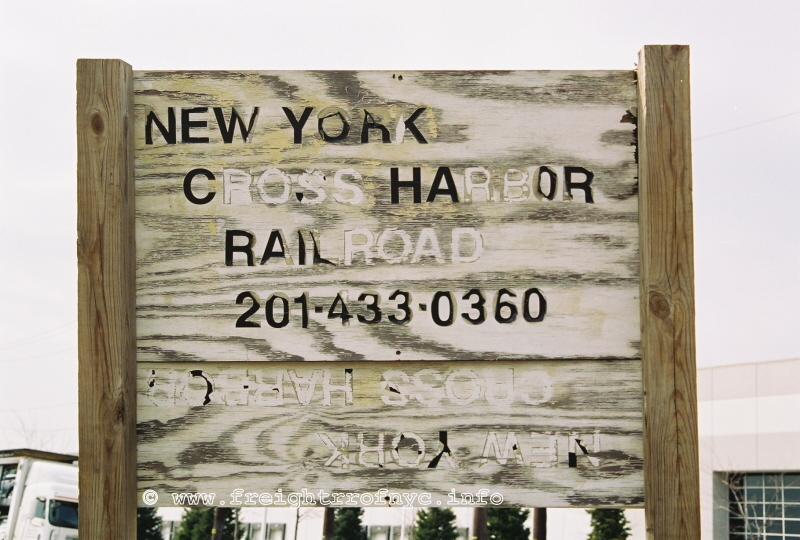
An old sign on the main entrance road to Greenville
Yard - February 26, 2009
P. M. Goldstein photo
.
It was said that part of a revised agreement in 1983, that Conrail would maintain the yard and floatbridges in Greenville, with New York Cross Harbor Railroad doing the switching and carfloat work.
However, after two float bridges collapsed (#13 & 14 or the southernmost two) around 1991 and with Conrail refusing to repair them, ownership of the float bridges and structures, along with the floating rights were transferred to New York Cross Harbor Railroad, but the land remains Conrail Shared Assets owned. See the float bridge chapter for more information.
Most of the float bridges are still there, albeit in various states of disrepair; except for #11 which is in service at this time. Number 11's outer apron was replaced in 1994, and numbers 13 and 14 which were dismantled in 1997, following the partial collapse of the suspension gantry.
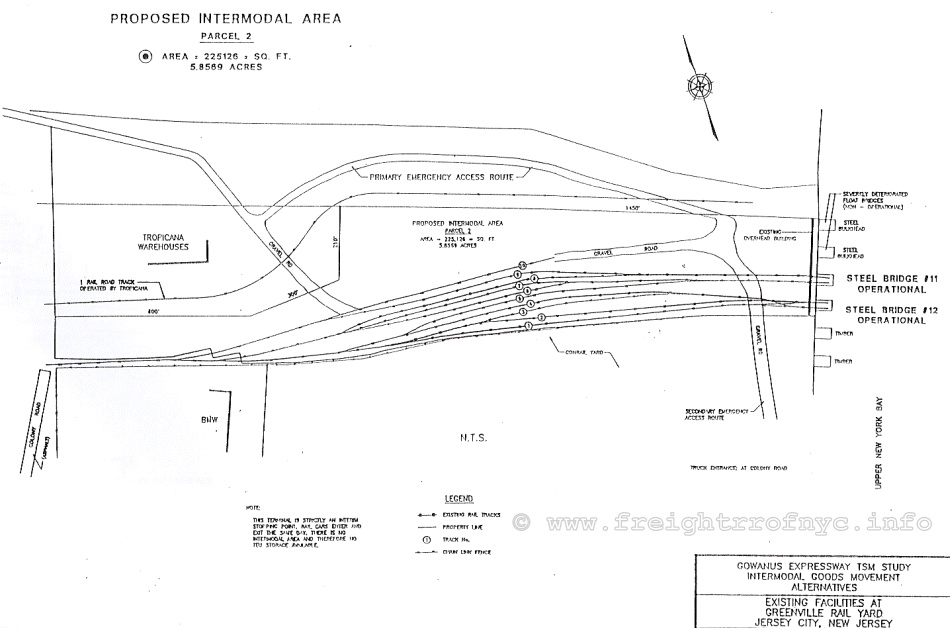
Note that this shows 12 Bridge as operational!
As 12 Bridge was operational until 1992, this map and the others as part
of the TSM Study must predate that year.
P. M. Goldstein collection
.
.
Tracks were numbered in Greenville as following: 12-3 (southern most), 12-2, 12-1, 11-4, 11-3, 11-2, 11-1 and the Crane Track. Greenville is currently comprised of approximately 27 acres.
Greenville itself never really had any customers other than being a transload operation until 2006; at which time a new consignee would receive boxcars filled with hay on the Crane Track. This customer is still in operation and received this commodity to this day.
|
|
|
.
. |
|
|
| .
. |
|
|
| .
. |
|
|
| .
. |
|
|
| .
. |
|
|
| .
. |
|
|
| .
. |
|
|
| .
. |
|
|
| .
. |
|
|
| .
. |
|
|
| .
. |
|
|
| .
. |
|
|
| .
. |
|
|
| .
. |
|
|
| .
. |
|
|
| .
. |
|
|
| .
. |
|
|
| .
. |
|
|
.
The Intermodal Bogies
The Bogies are a set of experimental Intermodal cars that were used by the Long Island Rail Road in the late 1980’s through the early 1990’s. The entire purpose of these cars was to be able to introduce Intermodal type services to businesses located on Nassau & Suffolk Counties on Long Island. The reason that it took so long to offer this intermodal type service was the fact that LI (and much of the East Coast) is plagued with some very low clearances which will not accept the traditional double stack containers (COFC) or trailer on flat car (TOFC) services. Traditional Intermodal well type cars will not clear the electrified 3rd Rail adjacent to the tracks for commuter trains as well.
The biggest obstacle on Long Island being the bridges in Mineola. The use of the Bogies solved this problem. This is somewhat ironic being that LIRR helped to pioneer Intermodal in the 1800’s by placing wagons on flat cars destined for New York City. In the late 1980’s, LI was in a crisis of overloaded roads and something had to be done…
The Intermodal Bogie concept was developed in the late 1970's, by a company known as Intermodal Concepts, Inc. Intermodal Concepts under George B. Kirwan, developed a small, two axle bogie, where a truck trailer would be backed onto a car, using a small ramp. The trailer would be supported, and another car would be rolled into place and connected with a normal fifth wheel hitch. A small set of these cars were built, however information is extremely scarce about them. Research on these original cars is ongoing.
© 2017 - www.freightrrofnyc.info
In early 1988 under Dan Cleary, the Freight General Manager of LIRR, the Freight Division of the Long Island Rail Road was looking to expand its freight marketing and start moving intermodal trailers. By this time, Intermodal Concepts had developed a new, more refined set of bogies on the drawing board, which used a crane to place the trailers onto the cars, instead of having the truck itself perform the complicated task of backing the trailer onto the car.
The Berwick Freight Car Company of Berwick, Pennsylvania (then a subsidiary of Chicago West Pullman Heavy Industries) were contracted to build the first cars. Berwick was a known freight car builder with a line of well known box cars and would later develop the ULTRA (universal load, twin railcar, articulated) containerized waste cars in 1991. The Bogies were LIRR's grand plan to help bring back a more marketable freight service to Long Island. Due to the nature of the cars (we will get into more detail about this later on), the cars were not really intended for interchange service with other railroads.
LIRR set up a permanent terminal at the Pinelawn Team Track just east of Farmingdale, and a not so permanent facility at the Garden City Team Track on the Garden City Secondary. The western terminus would be located on the property of the New York Cross Harbor Railroad in Greenville Yard, in New Jersey. New York Cross Harbor RR became the “partner” for the Bogie service. The Bogies would be loaded by NYCH in NJ, carfloated to the New York side of the harbor, and interchanged with the LIRR in Brooklyn's Bay Ridge / 65th Street Yard. This would be the only route the cars would ever take.
The first batch of cars, and the pair of custom unloading cranes were completed by April 1988. Berwick held the title on this equipment, and leased them to LIRR for testing. The first batch consisted of twelve cars, which were bought to Greenville, NJ loaded on flatcars, and subsequently offloaded there. The goal of leasing instead of selling outright the bogies first was to see if there was enough demand for the service, and/or to develop marketing for it.
The cars were unlike anything ever built at the time, featuring some very sleek lines on a very low profile, yet had a heavily built chassis. What made these cars interesting was the fact that the trailer body itself became an important part of the unit. The trailer would be loaded so that the pin on the front would be in a fifth wheel hitch, and the wheels would be in a set of pockets on the next car, thus the center of the trailer would be “floating” over the rail.
Second Bogie Patent (for which the prototype LIRR cars were built off of)
.
Customers
The bogies initial run was in July of 1988. The first customer being the Town of Hempstead waste incinerator in Garden City, NY. Incinerator ash, being handled by Interstate Bi-Modal, was loaded in 20' open top containers on a trailer chassis, and were loaded on the bogies using a truck mounted crane. The trailers were lifted by crane using a normal spreader bar setup attached to the boom, which is oddly enough painted the exact same color blue as the cars. It is possible this was part of the order for loading the cars in remote areas.
At the same time of delivery, the cars were being used by Multimodal of New Jersey, who was a shipping broker for small trucking outfits. These cars were also loaded in Garden City, NY and later in Pinelawn, NY as well. When the operation was moved full time to Pinelawn and the unloader was set up, the US Postal Service came on as a user, of whom shipped mail. USPS was a customer until one of the loaded trailers which had been left overnight on one of the interchange tracks, was set on fire. The last known customer was Clare Rose Distributors, a LI based beverage dealer. Clare Rose was the last active consignee to use the service, that being until December 1991. Clare Rose apparently had a few bad run ins with the service. First, a loaded trailer of beer was dropped in Greenville Yard, causing serious damage to the load. The second, a loaded trailer of empty bottles on the return trip west was struck and ruptured on the interchange tracks in Brooklyn, scattering empty bottles everywhere.
The Different Types
There were three different kinds of Bogie cars, as outlined below:
#8000 series:
These were designated end cars, featuring a standard height tight lock (Type H) coupler and a set of cast steel counterweights to offset the weight of the trailer on the other end, and a fifth wheel hitch on the other end. This was followed by a lower then normal height Type E coupler on the opposite end of which it's purpose was to move sets of unloaded/empty bogies.
Following an 8000 series bogie in the train, would be a 1000 series car.
#1000 series:
These were the designated intermediate cars. These had lower height Type E couplers on both ends. The reason for the lower coupler height was so that a 1000 series car could never be coupled to a standard freight car.
On the “A End”, or front of the car, would be a well in which the axle sets from the first road trailer would sit in. On the “B End”, or rear of the car, was a fifth wheel hitch for the next trailer. The wheel wells featured a spring loaded chock mechanisms, which kept the tires locked in at all times. These wheel wells were pretty interesting in the fact that the entire wheel well assembly was able to pivot slightly, so that the car could negotiate curves better with a loaded trailer.
Following the 1000 Series car in the train (in actuality there would be several, but were going to skip to the end here) would be a 9000 Series bogie.
© 2017 - www.freightrrofnyc.info
#9000 series:
These cars had a low height Type E coupler on the “A End", and a normal height, Type H tight lock coupler on the "B" or rear end. The front had a set of wells for the last road trailer's tires to sit in. This unit is essentially the opposite of the front 8000 series car.
In service, the normal configuration of bogies would be to have the following cars in a train:
80xx - 10xx - 10xx - 10xx - 10xx - 90xx
This allows for one set to accommodate up to five road trailers.
All of the cars did have some similarities throughout their design. Each car had its own braking system, a standard freight car AB brake set. Handbrakes were the standard Ajax brake wheel, located on the “B” end of each car. Due to the fact that the cars would essentially be stretched out, the air brakes had to be connected by a long flexible hose. Each car had its own retractable reel (think of a retractable drop light) with a brake hose wound on it mounted on the car. The original cars had them mounted under the fifth wheel, with the second order of bogies having larger red hose reels mounted on the side of the car opposite the brake wheel. On the cars with the wells for the wheels, they were pretty standard with a wedge designed to keep the trailer from moving around. This also was refined on the second order of cars and the first order of cars were subsequently modified with an extra piece of steel on the top to better lock the tires down.
After initial testing, the LIRR claimed they had sufficient demand for their use, and pursued funding for additional bogies. In July of 1990, they received a grant from the New York State Department of Transportation that allowed the purchase of the original twelve cars from Berwick, the pair of trailer unloaders, as well as funding for thirty-three additional bogies, costing a grand total of $924,000. However, not all was good with the service as LIRR touted. In 1994, a New York State ordered audit of the LIRR Freight Department, found that there was very little demand for the bogie service, and LIRR did not commence with proper marketing to advertise this service. The kicker was when they received the $924,000 grant in 1990, they in fact had no customers using the bogies at that time.
The second batch of Bogies were built in August of 1991, and were delivered to Long Island in September. At that time, the only customer using the bogies was Clare Rose beer distributors, who would only use the bogie service until December of 1991, which turned out to be the last time the bogie were ever used. Of the thirty-three new cars that arrived in September, approximately ten to fifteen were ever actually used in service. Thus, most of the bogie fleet was never even used a single time.
Around the same period of time, New York Cross Harbor RR also requested additional conditions to be met, and as a result the LIRR discontinued using the bogies. One must consider, the extent of the bogie's trip was all of a whopping 35 miles each way. Charging enough to cover the costs of two railroads is hard to compete with the affordability and competitiveness of local trucking. At the time of the 1994 Audit, the LIRR had plans to continue marketing the bogie service to try and drum up business, but this never panned out.
The end of the Bogies...
The bogies themselves had there own design issues. They were very light cars and had to be treated carefully. The Federal Railroad Administration put a restriction on the cars to operate with more then 15 trailers per train. LIRR even went to the effort of producing a booklet for train crews on how to handle the cars properly. If the thirty-nine months that the Bogies were available for use, only 4 customers ever used the service. The US Postal Service and Clare Rose were the largest users of the cars.
Following the discontinuation of Bogie service, the cars would be stored in Yard A in Long Island City, and Fresh Pond Yard in Queens. At some point eight of bogies in Long Island City were relocated to behind the old Yard A Hump. The cars in Fresh Pond Yard were moved up onto the Montauk Cutoff. In 2003, when work began on the East Side Access Project, the cars in Yard A were moved to the Montauk Cutoff as well, grouping together a total of thirty-three cars. The remaining twelve bogies are stored in Hicksville on the Long Island Lighting Co. siding. To this day, the cars are still there, covered in graffiti and completely overgrown. The unloader used by New York Cross Harbor RR in Greenville was scrapped in 2004, and the unloader in Pinelawn was scrapped in 2010. In December of 2014 a switch was installed on the Cutoff to facilitate the moving of the bogies for scrap. As of January 2017, the bogies have yet to be moved.
The LIRR had high hopes for the cars, with only 17,131 freight cars moved in 1987, and 11,962 in 1991. The goal was to use the bogies to try and win back some of the freight traffic lost to truck competition, but the LIRR never pushed the service enough apparently. Combine this with the end of NY Freight Rail Subsidies ($375,000 in its last year), the LIRR needed something to get more revenue. The plan was that if the bogies succeeded would have been to build terminals for them at Hicksville, Ronkonkoma, Republic, and Holtsville.
Intermodal Concepts, the group that came up with this idea, is never mentioned in any of the Bogie reports, paperwork or any other literature. The group patented several various ideas relating to using different types of Bogies, as well as other methods of hauling trailers on the railroad. Unfortunately, there is very little information on this company so far.
Technical Data
The 12 original cars were 8001, 8002, 1001-1008 and 9001 & 9002.
The second order of thirty-three cars included 8003-8007, 1009-1031 and 9003-9007
All the cars used “LIRR” as there painted on reporting mark, however LIRR's actual registered reporting mark is “LI”. It is unknown why this was done. The large fleet of LIRR ore cars used “LIRR” as well. It is assumed it is due to the fact that the cars were never interchanged in general service.
The bogies stored in Hicksville on the LILCo siding are: 8001, 8007, 1004, 1005, 1006, 1007, 1008, 1009, 1010, 1012, 1026, 9002, and 9007. The remainder of the cars are in Long Island City on the Montauk Cutoff.
Due to the fact that the Bogies were low profile cars, they all used 28” wheels and all the bogies were 2 axle cars. All of the cars were only 33” tall, from the railhead to the top of the deck, not counting any of the grabs, fifth wheel hitches, etc. The cars were a little over 10' wide (122 inches). 8000 Series cars were 17' 6” long; 1000 Series cars were 23' 6” long; and 9000 Series cars were 21' long; none of these dimension include the couplers.
The first twelve cars weighed in at: 8000 Series cars were 16,800 lbs.; 1000 Series cars at 18,800 lbs. and 9000 Series were also 16,800 lbs. The second order of cars weighed the following: 8000 Series were 18,850 lbs.; 1000 Series cars were 18,740 lbs. and 9000 Series cars were 17,705 lbs.
The first cars to come to LI had all of there lettering painted in Black. The first batch of the second order were also delivered with black lettering, however the later ones in the series came with white lettering. LIRR started to repaint some of the early cars to white lettering, however not all were done.
|
|
|
|
| © 2017 - www.freightrrofnyc.info
© 2017 - www.freightrrofnyc.info |
|
|
| © 2017 - www.freightrrofnyc.info
© 2017 - www.freightrrofnyc.info |
|
|
|
© 2017 - www.freightrrofnyc.info
© 2017 - www.freightrrofnyc.info |
|
|
| © 2017 - www.freightrrofnyc.info
© 2017 - www.freightrrofnyc.info |
|
|
| © 2017 - www.freightrrofnyc.info
© 2017 - www.freightrrofnyc.info |
|
|
| © 2017 - www.freightrrofnyc.info
© 2017 - www.freightrrofnyc.info |
|
|
| © 2017 - www.freightrrofnyc.info
© 2017 - www.freightrrofnyc.info |
|
|
| © 2017 - www.freightrrofnyc.info
© 2017 - www.freightrrofnyc.info |
|
|
| © 2017 - www.freightrrofnyc.info
© 2017 - www.freightrrofnyc.info |
|
|
| © 2017 - www.freightrrofnyc.info
© 2017 - www.freightrrofnyc.info |
|
|
| © 2017 - www.freightrrofnyc.info
© 2017 - www.freightrrofnyc.info |
|
|
| © 2017 - www.freightrrofnyc.info
© 2017 - www.freightrrofnyc.info |
|
|
| © 2017 - www.freightrrofnyc.info
© 2017 - www.freightrrofnyc.info |
|
|
| © 2017 - www.freightrrofnyc.info
© 2017 - www.freightrrofnyc.info |
|
|
| © 2017 - www.freightrrofnyc.info
© 2017 - www.freightrrofnyc.info |
|
|
|
© 2017 - www.freightrrofnyc.info
© 2017 - www.freightrrofnyc.info |
|
|
| © 2017 - www.freightrrofnyc.info
© 2017 - www.freightrrofnyc.info |
|
|
| © 2017 - www.freightrrofnyc.info
© 2017 - www.freightrrofnyc.info |
|
|
| © 2017 - www.freightrrofnyc.info
© 2017 - www.freightrrofnyc.info |
|
|
|
© 2017 - www.freightrrofnyc.info
© 2017 - www.freightrrofnyc.info |
|
|
| © 2017 - www.freightrrofnyc.info
© 2017 - www.freightrrofnyc.info |
|
|
| © 2017 - www.freightrrofnyc.info
© 2017 - www.freightrrofnyc.info |
|
|
| © 2017 - www.freightrrofnyc.info
© 2017 - www.freightrrofnyc.info |
|
|
| © 2017 - www.freightrrofnyc.info
© 2017 - www.freightrrofnyc.info |
|
|
| © 2017 - www.freightrrofnyc.info
© 2017 - www.freightrrofnyc.info |
|
|
| © 2017 - www.freightrrofnyc.info
© 2017 - www.freightrrofnyc.info |
|
|
| © 2017 - www.freightrrofnyc.info
© 2017 - www.freightrrofnyc.info |
|
|
| © 2017 - www.freightrrofnyc.info
© 2017 - www.fr |
|
|
| © 2017 - www.freightrrofnyc.info
© 2017 - www.fr |
|
|
| © 2017 - www.freightrrofnyc.info
© 2017 - www.fr |
|
|
| © 2017 - www.freightrrofnyc.info
© 2017 - www.fr |
|
|
| © 2017 - www.freightrrofnyc.info
© 2017 - www.fr |
|
|
| © 2017 - www.freightrrofnyc.info
© 2017 - www.freightrrofnyc.info |
|
Ephemera |
|
|
| © 2017 - www.freightrrofnyc.info
© 2017 - www.freightrrofnyc.info |
|
|
| © 2017 - www.freightrrofnyc.info
© 2017 - www.freightrrofnyc.info |
|
|
|
© 2017 - www.freightrrofnyc.info
© 2017 - www.freightrrofnyc.info |
|
|
| © 2017 - www.freightrrofnyc.info
© 2017 - www.freightrrofnyc.info |
|
|
© 2017 - www.freightrrofnyc.info
Unfortunately, there has been extremely little information written on these bogies over the years, short of a handful of “paragraphs” in magazine articles here and there. Much of the work written here is from my own first hand knowledge spent studying the cars and there designs. There are a few tidbits of further reading:
NYS Comptrollers Report on Long Island Rail Road Freight; Report 93-S-90
"Piggyback Service Coming Home to Long Island"; by Bill Blyer, Newsday, 2/29/88
"New LIRR Freight Setup on a Roll", by Bill Blyer; Newsday, 4/24/90
"The Railroad that goes to Sea" by Carl Perelman, Railpace Magazine, 9/92
LIRR "Along the Track" newsletter, July / August 1988
Special thanks to Joel Torres, who provided the Long Island Rail Road Freight Department images, as well as insight to the operation.
.
.
Outbound Subway & Commuter Cars for Scrap
Throughout the 1980's, the New York Cross Harbor Railroad received a contract for the handling of scrap subway cars for the New York City Transit Authority.
These cars were loaded directly onto carfloats and shipped to Greenville, NJ. Some were scrapped right in the yard in Greenville by Abato Bus Sales, while others were sent to Naparano Iron & Metal in Newark, NJ.
Also, a handful of the retired Long Island Rail Road Budd M1 "Metropolitan" cars were loaded on top of 89' flatcars by the Long Island Rail Road. These cars were then sent to Bush Terminal and subsequently carfloated to Greenville, NJ. Actually, only very few M1's went this way; with the majority of the shipment going via Canadian Pacific Rail on the New York Connecting Railroad.
Also being sent out for scrapping, were Long Island Rail Road P72 / 75 Class cars. These were put on a carfloat where they were taken to Newark, NJ to be scrapped. Known cars included #2902, #2832, #2785, #2895, #2797 & #2871.
Inbound Subway & Commuter Cars
During the 1980's; the Metropolitan Transportation Authority (the parent organization for the New York City Transit Authority, Staten Island Rapid Transit, Metro-North and Long Island Rail Road); commenced with a major system-wide fleet modernization program.
As the scrap cars were sent out (as mentioned in the above chapter), new and rebuilt cars would arrive to replace the obsolete cars. Most of the new subway cars constructed by Bombardier and Kawasaki; as were the rebuilds from Morrison-Knudson; came into Brooklyn from Greenville, NJ via carfloat. These subway cars were loaded on top of flatcars "piggy back style", with trucks installed and "ready to roll". These cars were unloaded either in Bush Terminal the South Brooklyn Railway's yard at 38th Street & Third Avenue, or in a very rare instance, new subway cars were unloaded directly from a freighter onto a carfloat.
To unload the last order of R46 subway carso that arrived loaded upon flatcars, an earthen unloading ramp was built in 1992 at the northern end of the Bush Terminal Yard, just east of the enginehouse. This ramp was also used to unload newly arrived refuse collection trucks for the Department of Sanitation of the City of New York which arrived "TOFC style" upon flat cars
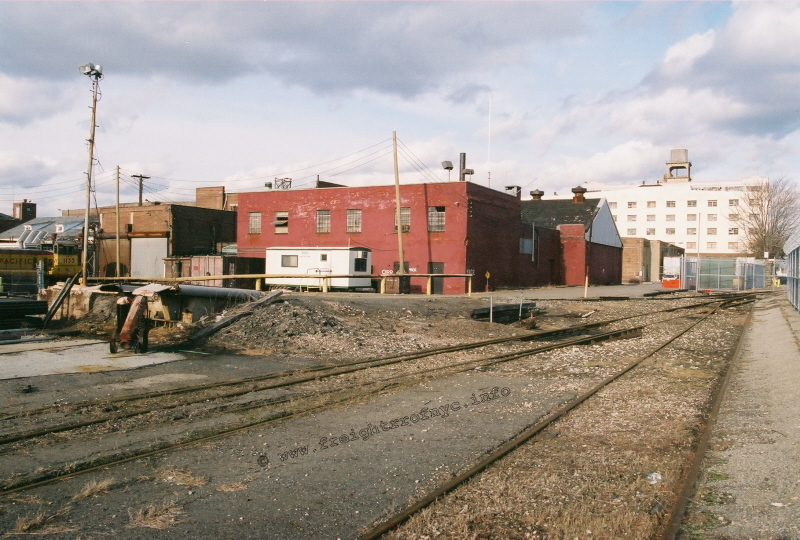
Subway Car Unloading Ramp (ground view) at Bush Terminal
Yard, Brooklyn, NY - January 2010
P. M. Goldstein photo
.
.

Subway Car Unloading Ramp (elevated view) at Bush Terminal Yard, Brooklyn,
NY - January 2010
P. M. Goldstein photo
.
.
A similar ramp made of railroad ties in located at the nearby South Brooklyn Railway Yard at 38th Street and Third Avenue (see South Brooklyn Railway for images).
Also during this time, Metro-North sent some of their Budd M4 electric commuter cars to NemCo, located in the Brooklyn Navy Yard, thus giving the Brooklyn Navy Yard one last fleeting moment of carfloating glory.
Ironically, the New York Cross Harbor Railroad also carfloated the rebuilt Port Authority Trans Hudson (PATH) PA 1 cars to and from the Brooklyn Army Terminal Yard at 65th Street, where the PA1's were rebuilt by New York Railcar Company.
It is amusing that not one but both of Brooklyn's former military properties would be home to railcar rebuilders and New York Cross Harbor Railroad would have the honors to provide carfloat service to both.
In 1999, when the Long Island Rail Road was modernizing their passenger car fleet; the brand new Bilevel cars were delivered via the New York Cross Harbor Railroad. These cars were carfloated into Bush Terminal and then delivered to New York & Atlantic Railway at 65th Street.
Timing was important, and a "headlight to headlight meet" was needed to prevent any sort of vandalism to the brand new, million dollar commuter cars.
Valley Railroad #1647
In January of 1990, the New York Cross Harbor Railroad had the honor of transporting the (then) brand new Valley Railroad 2-8-2 #1647.
This steam locomotive was built brand new by Tan Shan Locomotive Company located in the Peoples Republic of China. #1647 was then shipped over by freighter and offloaded in New Jersey. Then, it was carfloated over to Bush Terminal and transported to the Brooklyn Army Terminal by New York Cross Harbor Railroad for interchange with Long Island Railroad.
|
|
|
. . |
|
|
|
. . |
|
|
| .
|
|
|
| .
. |
|
|
| .
. |
|
|
| .
. |
|
|
| .
. |
|
|
.
#1647 is still around today, operating as New York, Susquehanna & Western Railroad #142.
Inbound Plasser Track Geometry Car
Also taking place in 1999, a new Plasser-American Track Geometry Car was purchased by the Long Island Railroad. This Geometry Car was carfloated into Bush Terminal, and as before hauled to 65th Street for interchange with the New York & Atlantic Railway.
Outbound GP38-2's and Inbound DE / DM30AC
Undertaking another fleet modernization, the Long Island Rail Road also shipped their fleet of aging GP38-2 locomotives back to ElectroMotive Division (EMD).
These locomotives were shipped with the assistance of the New York Cross Harbor in late 1999. The locomotives were stored in Bush Terminal, then carfloated over to Greenville, several at a time.
Some of the new replacement engines, the DE and DM30AC locomotives were transported inbound to Long Island Rail Road via the New York Cross Harbor Railroad.
Heavy Vehicles
In the late 1980's, New York Cross Harbor Railroad moved a load of trucks to the Atlantic Basin for ship side direct lightering.
These trucks, which had been received already loaded upon flatcars; had in turn been loaded onto a carfloat by New York Cross Harbor Railroad. The carfloat was then tied up next to the ship, and ship board cranes hoisted the trucks aboard. The trucks were destined for Istanbul, Turkey.
Miscellaneous Data
& Information
.
Eared Knuckles
"Eared" knuckles are a special type of coupler knuckle that were utilized on locomotives working carfloats for Marine-Rail outfits:
These knuckles had extensions cast into the top and bottom of the knuckle, which allowed for extra vertical movement of the adjoining coupler on the car being towed (which were without eared knuckles).
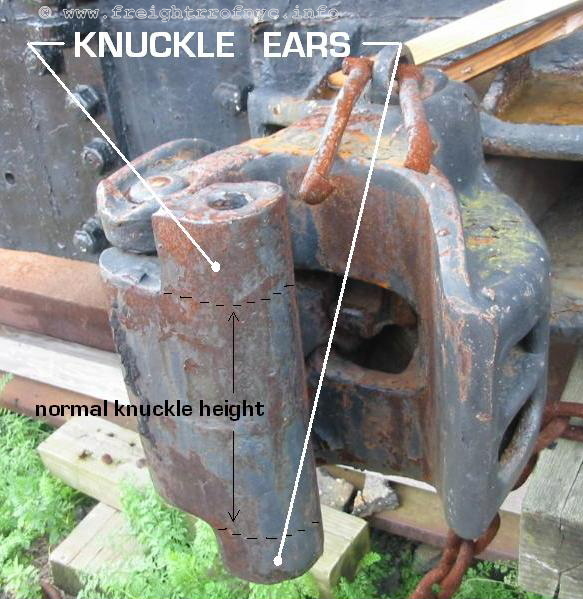
"Eared knuckle" on coupler for carfloat / float bridge
work.
P. F. Strubeck photo
.
This was crucial when moving cars over the rather sharp and abrupt angle changes in either approaching the apron from land or from the apron to the carfloat.
Only a few New York Cross Harbor Railroad locomotives were equipped with these types of eared knuckles, and if they were so equipped, it was early on in the 1980's.
For an unknown reason, the eared knuckles were removed.
It is also believed that when a new locomotive was acquired, the eared knuckle off the locomotive that it was replacing was transferred to the newly arrived locomotive,; but this has not been positively confirmed.
The photo above, is of the eared knuckle on BEDT 16. All of BEDT's locomotives (steam & diesel) were equipped with eared knuckles, front and rear.
Rerail Frogs
On the original New York Cross Harbor Railroad fleet, a special sheet metal side was added to the last handrail sanction on the engineers side extending to the cab. This small box like enclosure was on there to hold rerail frogs and heavy ropes.
Brooklyn Eastern District Terminal #16
In late 1992, BEDT 16, a H. K. Porter 0-6-0T; was moved from is long abandoned state in front of the old Kent Avenue enginehouse to the Bush Terminal enginehouse. At this time, a few different groups tried to claim ownership. Later on, shop forces of New York Cross Harbor Railroad painted 16 to a makeshift BEDT scheme and even replaced the number plate.
While this restoration was not 100% correct or prototypical, this makeshift restoration made it presentable. It has since been said, that the this makeshift restoration was done to commemorate the retirement of Harry Lynch; a locomotive engineer for Bush Terminal Railroad, New York Dock and subsequently the New York Cross Harbor Railroad.
In 1999, the Railroad Museum of Long Island acquired 16 and it was moved to their Riverhead Restoration Site.
New York Cross Harbor Railroad
Police
.
Beginning in the early 1990's, the New York Cross Harbor Railroad organized and employed its own police force.
The New York Cross Harbor Railroad Police Department employed a full time Police Chief, in addition to about a dozen "Reserve Special Agents" , who in turn were commanded by the "Reserve Superintendent of the Railroad Police".
In reality, the principal duty of the New York Cross Harbor Railroad Police Department was traffic control on freight movements that transversed First Avenue among the other city thoroughfares.
The New York Cross Harbor Railroad Police Reserve held training drills on the property, as well as assisting with security during events and affairs concerning Robert Diamond and Brooklyn Historic Railway Association.
Most of the Reserve Agents had been previously employed in some facet of law enforcement. The uniform was a light blue shirt, with blue jeans and work boots. Gold colored badges were also issued for use. A pair of patches were used: one design was for property protection, and the other design for train protection. Both were worn, with one on each sleeve of the shirt.
|
|
|
.
.
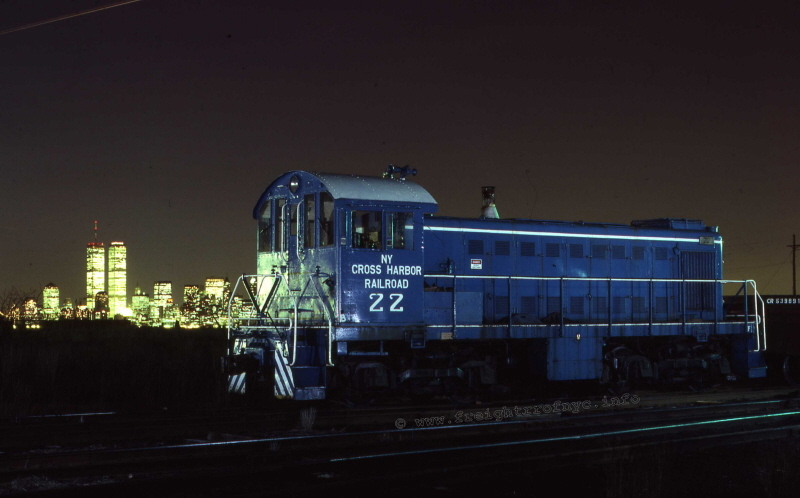
Greenville, NJ - April 3, 1986
A. Tillotson photo
P. F. Strubeck
collection
added 02 June 2010
When the New York Cross Harbor Railroad was organized, it acquired all the locomotives from the 1978 New York Dock / Brooklyn Eastern District Terminal merger. Some of these locomotives would go on to be used, others would become parts donors, and some surplus for sale.
From the beginning of operations in August 1983, the New York Cross Harbor Railroad used several of the ex-Brooklyn Eastern District Terminal American Locomotive Company Model S-1 locomotives. Locomotives used were 22, 25; with 21 originally being stored with the remainder of the surplus locomotives but would be reactivated by New York Cross Harbor Railroad.
Also, New York Cross Harbor Railroad operated the pair of ex-New York Dock ElectroMotive Division Model NW-2's: which were numbered #58 and 59. Number 59 would have the honor of being the first locomotive to be painted in the new New York Cross Harbor Railroad livery scheme.
New York Cross Harbor Railroad chose not to utilize three of the former Brooklyn Eastern District Terminal S1's (#23, 24 & 26) which served as parts donors for #21, 22 and 25, nor did they operate either of the pair of the former New York Dock's American Locomotive Company Model RS-3's or any of the four General Electric Model 44 Tonners (#51, 52, 54 or 55).
The unused and surplus locomotives (the two RS3's, four 44 tonners and three S1's were first stored in the Brooklyn Army Terminal for eventual parts use (as the BEDT S1's would be) or stored in the hopes another railroad would purchase them outright for use. This only occurred with one locomotive: New York Dock #55. This locomotive was sold to Eastern Railcar in New Jersey, which has since be resold to East Penn Railroad.
Soon after the locomotives being placed in the Brooklyn Army Terminal however, the remaining locomotives would be stored on a carfloat, and moved to the former New York Dock Fulton Terminal. It would be moored to the pier until January 1986, at which time the carfloat that the locomotives were stored on, was relocated to Newark, NJ; and all units were scrapped at this location.
The first locomotive to actually have been purchased by New York Cross Harbor Railroad was #11, an American Locomotive Company model S4. This locomotive was purchased from the Massena Terminal Railroad in upstate NY, where it was also their #11. Massena Terminal purchased this locomotive new. Unfortunately in 2000, #11 blew it's turbocharger and sat idle until June 2006 which at such time it was scrapped in the Greenville Yard.
The Alco model S4 is almost identical in appearance to the model S1, with the only differences between the models being that the engine on the S4 was equipped with a turbocharger, which resulted in a trapezoidal base exhaust stack. The S1 model is not turbocharged and has a conical base exhaust stack. The other significant difference is that the S4 model rides on AAR Type A switcher trucks and the S1 model rides on Alco "Blunt" trucks, which have a "thinner" and "lighter duty" appearance.
In October of 1997, New York Cross Harbor leased SW1500 #9607 from Conrail for an as yet unknown span of time.
In 2000, New York Cross Harbor Railroad purchased a General Electric model U23B. This locomotive did not see service often, and would be sold in 2006.
Also in 2000, the New York Cross Harbor Railroad purchased three ex-Green Bay & Western American Locomotive Company model C424 (Century 424) locomotives. The New York Cross Harbor Railroad planned to make "mother-slug" sets out of these locomotives with the retired ex-BEDT Alco S1's. But this never happened and the plans came to naught.
In 2004, New York Cross Harbor Railroad purchased two ex-Union Pacific Yard (UPY) Electro Motive Division model SW-1500 Switchers. One of these locomotives remains in service today. The other unit was sold / traded to Juniata Terminal and is no longer on the property.
The New York Cross Harbor Railroad has leased other locomotives over the years. These mostly BDLX units, of which denotes Big Dog Leasing. One of these locomotives, #2293 was overhauled in 2006. During this period, New York Cross Harbor Railroad borrowed / leased a locomotive from the Morristown & Erie Railroad, #563.
Locomotive Livery & Paint
Schemes
.
Over the years, the New York Cross Harbor Railroad has employed the use of a few interesting paint schemes and heralds that were used on the locomotives.
First Generation, 'A' Variant: 1983 - 1989
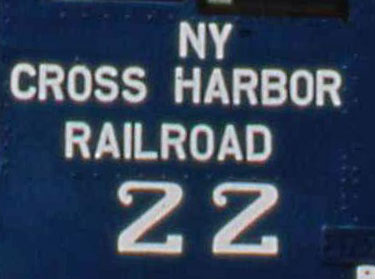
.
Originally when New York Cross Harbor Railroad was organized, in those first few weeks of operation, they used "patched", i.e. the letters BEDT on the engine doors and cab sides painted over, and with NY Cross Harbor Railroad lettering now on the side of the cabs. The handrails remained yellow.
Locomotives 22 and 25 wore this patched BEDT livery for the first few months of operation in 1983. Shortly thereafter, the locomotives were painted blue with a white hood stripe, white handrails, white safety stripes on the front & rear pilots, white cab roof, but with the same text on the cab sides.
When locomotive #21 was re-activated in 1985, it too wore this patched BEDT livery for a few weeks of operation until being repainted, of which by this time the B Variant was in use.
.
First Generation, 'B' Variant: 1984 - 1989
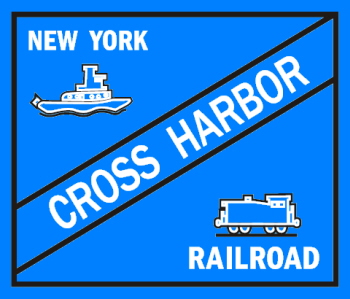
original design by B. Schaeffer
website artwork by J. Otto
.
In 1983, Locomotives #58 and 59 were also painted into the blue scheme as mentioned above, however they did not receive the cab lettering. #58 and 59 operated with no lettering on the cab sides until late 1984. At this time, the herald designed by Benjamin Schaeffer (a very prominent and well regarded railroad historian and railfan of the Metro New York Area) was adopted for use on the New York Cross Harbor Railroad locomotives.
As mentioned above, #21 received this logo.
.
Second Generation: 1989 - 1998
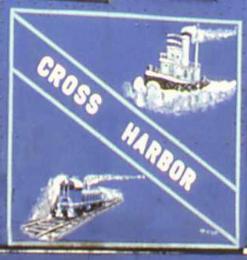
In 1989, a more refined variation of Ben Schaeffer's herald was created. The new design now had an "air brushed" style to the images of the tugboat and locomotive (as opposed to the outline drawing appearance of the first generation herald).
However, while the diagonal "CROSS HARBOR" in the first generation herald is solid, the diagonal lettering of "CROSS HARBOR" in the second generation appears to be a stencil.
At this time, the color scheme of the overall locomotive was also changed. Locomotives were now painted with the majority of the carbody in medium blue, with a white hood stripe and the top of the carbody in teal blue. However, #59 was an exception in that it did not have the white stripe and the medium blue and teal blue were next to each other with no dividing line.
Locomotives #11, 21, 22 and 25 received this livery circa 1989, with #59 following in 1991. #58 did not receive this livery as it was already out of service.
.
Third Generation: 1998 - 2006

.
In 1998, the New York Cross Harbor Railroad completely changed the livery of it's locomotives. The locomotives would now be painted in all black with yellow highlights. A new herald: "Cross Harbor" with opposing arrows above and below the letters, held its debut.
Locomotive #1337 & #11, would receive the new black & yellow paint scheme, however #11 would receive only the new "opposing arrow" herald.
All other operable locomotives obtained and utilized after this livery was released, remained in their original or as delivered liveries, until New York New Jersey Rail ownership.
..
| 21 |
|
|||||
| 9607 |
|
|
|
.
. |
|
|
| .
. |
|
|
| .
. |
|
|
| .
. |
|
|
| .
. |
|
|
| .
|
|
|
| .
. |
|
|
| .
. |
|
|
| .
. |
|
|
| .
. |
|
|
| .
. |
|
|
|
.
. |
|
|
| .
. |
|
|
| .
. |
|
|
| .
. |
|
|
| .
|
|
|
| .
. |
|
|
| .
. |
|
|
| .
. |
|
|
| .
. |
|
|
| .
. |
|
|
| .
. |
|
|
| .
. |
|
|
|
.
. |
|
|
| .
. |
|
|
| .
. |
|
|
| .
|
|
|
| .
. |
|
|
| .
. |
|
|
| .
. |
|
|
|
.
. |
|
|
|
.
. |
|
|
| .
. |
|
|
| .
. |
|
|
| .
. |
|
|
| .
. |
|
|
| .
. |
|
|
| .
. |
|
|
| .
. |
|
|
| .
. |
|
|
| .
. |
|
|
| .
. |
|
|
| .
. |
|
|
| .
|
|
|
| .
. |
|
|
| .
. |
|
|
| .
|
|
|
| .
. |
|
|
| .
. |
|
|
| .
|
|
|
|
.
. |
|
|
| .
. |
|
|
| .
. |
|
|
| .
. |
|
|
| .
. |
|
|
| .
. |
|
|
|
.
. |
|
|
|
.
. |
|
|
| .
. |
|
|
| .
. |
|
|
| .
. |
|
|
| .
. |
|
|
| .
. |
|
|
| .
. |
|
|
| .
. |
|
|
| .
. |
|
|
.
.
Please note:
All locomotives listed in the rosters below are standard gauge (56.5"
/ 4' 8 ½ ") and are of B-B (four powered axles) wheel
arrangement.
New York Cross Harbor
Locomotive Roster
| number / name |
builder |
model | c/n |
build date |
hp |
previous |
acquired |
disposition |
notes |
| 21 | ALCo | S1 | 75351 | 8/1947 | 660 | Union RR #453; Duffy (RR Equipment dealer); Silcott (RR Equipment dealer) BEDT #21 |
used 8/1983 (stored) ex-Brooklyn Eastern District Terminal |
retired 1991 scrapped 7/2006 |
originally stored 8/1983; activated 3/1985; stored for possible slug use |
| 22 | ALCo | S1 | 75525 | 10/1947 | 660 | New Orleans & Lower Coast #9013 Missouri Pacific #6604 Duffy (RR Equipment dealer) Silcott (RR Equipment dealer) BEDT #22 |
used 8/1983 ex-Brooklyn Eastern District Terminal |
retired 1993 scrapped 7/2006 |
stored for possible slug use |
| 25 | ALCo | S1 | 74962 | 10/1946 | 660 | Erie #307 Erie Lackawanna #307 BEDT #25 |
used 8/1983 ex-Brooklyn Eastern District Terminal |
Saved for preservation & painted
to New York Central #8625 livery. Currently on display at Riverside Park, NY |
|
| 58 | EMD | NW2 | 3645 | 9/1946 | 1000 | Southern #2234 Southern #1026 |
used 8/1983 ex-New York Dock |
retired 1987 scrapped 7/2006 |
stored for possible slug use |
| 59 | EMD | NW2 | 4753 | 11/1946 | 1000 | Southern #2253 Southern #1044 |
used 8/1983 ex-New York Dock |
sold 2001 to Clean Earth Remediation, Jersey City, NJ scrapped ca. 2015 |
|
| 11 | ALCo | S4 | 79219 | 12/1951 | 1000 | Massena Terminal #11 | used 1989 | scrapped 6/2006 | blown turbo1
ca. 2001 for sale 5/2006 |
| 9607 | EMD | SW1500 | 36155 | 12/1969 | 1500 | EMDX demonstrator #111 Indianapolis Union #29 Conrail #9607 |
leased 1997 | to CSXT #1096 to LLPX #208 |
leased by NYCH for unknown period of time. |
| 1337 | EMD | SW1200RS | A1574 | 12/1958 | 1200 | Canadian National #1337 Ohio Central #1337 Big Dog Leasing #1337 |
leased 1997 | returned to lessor 2000 | |
| 2293 | EMD | SW1200 | 31574 | 4/1966 | 1200 | St. Louis Southwestern #2293 Ohio Central #2293 Big Dog Leasing #2293 |
used 2000 from Big Dog Leasing; |
rebuilt summer 2006 by Juniata Terminal; transferred to NYNJ Rail 2006 |
|
| 2395 | GE | U23B | 40126 | 1/1975 | 2250 | Louisville & Nashville #2816 CSXT #3317 Reading, Blue Mt. & Northern #2395 |
used 2001 | sold 5/2006 Fore River Railroad #2372 |
|
| 1068 | EMD | SW1500 | 33152 | 10/1967 | 1500 | Southern Pacific #2461 Union Pacific Yard #1068 |
used 2004 National Railway Equipment; |
traded 5/06 to Juniata Terminal for? |
|
| 1133 | EMD | SW1500 | 35242 | 11/1967 | 1500 | Southern Pacific #2549 Union Pacific Yard #1133 |
used 2004 National Railway Equipment |
transferred to NYNJ Rail 2006 | |
|
. Locomotives acquired but not used by New York Cross Harbor |
|||||||||
| 23 | ALCo | S1 | 75526 | 10/1947 | 660 | New Orleans & Lower Coast #9014 Missouri Pacific #6605 Duffy (dealer) Silcott (dealer) Brooklyn Eastern District Terminal #23 |
used 1983 | scrapped 1/86 | used for parts |
| 24 | ALCo | S1 | 75527 | 10/1947 | 660 | New Orleans & Lower Coast #9015 Missouri Pacific #6606 Duffy (dealer) Silcott (dealer) Brooklyn Eastern District Terminal #24 |
used 1983 | scrapped 1/86 | used for parts |
| 26 | ALCo | S1 | 75354 | 8/1947 | 660 | Erie #313 Erie Lackawanna #313 Neosho Construction #460 American Electric Power #313 Silcott (dealer) Brooklyn Eastern District Terminal #26 |
used 1983 | scrapped 1/86 | used for parts |
| 51 | GE | 44 Ton | 30851 | 3/1951 | 380 | New York Dock #51 | used 1983 | scrapped 1/86 | ballasted to 50T |
| 52 | GE | 44 Ton | 30852 | 3/1951 | 380 | New York Dock #52 | used 1983 | scrapped 1/86 | ballasted to 50T |
| 54 | GE | 44 Ton | 31224 | 12/1951 | 380 | New York Dock #54 | used 1983 | scrapped 1/86 | ballasted to 50T |
| 55 | GE | 44 Ton | 31225 | 12/1951 | 380 | New York Dock #55 | used 1983 | sold 1985 to Eastern Railcar | ballasted to 50T |
| 56 | ALCo | RS3 | 78756 | 5/1951 | 1600 | Central of Georgia #114 New York Dock #56 |
used 1983 | scrapped 1/86 | |
| 57 | ALCo | RS3 | 78755 | 5/1951 | 1600 | Central of Georgia #113 New York Dock #57 |
used 1983 | scrapped 1/86 | |
| 319 | ALCo | C424 | 84547 | 5/1963 | 2400 | Pennsylvania #2415 Penn Central #2415 Conrail #2474 Green Bay & Western #319 Caddo, Antoine and Little Missouri #319 |
used 2000 | sold to Livonia, Avon & Lakeville RR |
to be used as slug mother never received or used |
| 320 | ALCo | C424 | 84554 | 6/1963 | 2400 | Erie Lackawanna #2412 Conrail #2486 Green Bay & Western #320 Caddo, Antoine and Little Missouri #320 |
used 2000 | sold to Livonia, Avon & Lakeville RR |
to be used as slug mother never received or used |
| 321 | ALCo | C424 | 84557 | 6/1963 | 2400 | Erie Lackawanna #2415 Conrail #2489 Green Bay & Western #320 Caddo, Antoine and Little Missouri #321 |
used 2000 | sold to Livonia, Avon & Lakeville RR |
to be used as slug mother never received or used |
Roster research by P. F. Strubeck, D. Keller, T. Darnell & P. M. Goldstein
Footnotes:
1
According to Mike DeLuca, New York
Cross Harbor attempted to reuse fuel oil from one of the tugboats in this
locomotive, however the fuel had been contaminated with seawater,
and caused engine failure.
Paul Strubeck's resources including
an advertisement in "RailSwap Classifieds" for this locomotive being sold
by New York Cross Harbor and as having a blown turbocharger. The classified
ad only ran a couple of weeks before engine was scrapped.
.
.
Tugboats
In the early years of operation, New York Cross Harbor Railroad used a pair of ex-Brooklyn Eastern District Terminal tugboats: the "Brooklyn III" and the "New Jersey" renamed "Cross Harbor I", to transport carfloats around New York Harbor.
After (date), New York Cross Harbor would solicit outside marine towing outfits for carfloat service.
| "Cross Harbor I" |
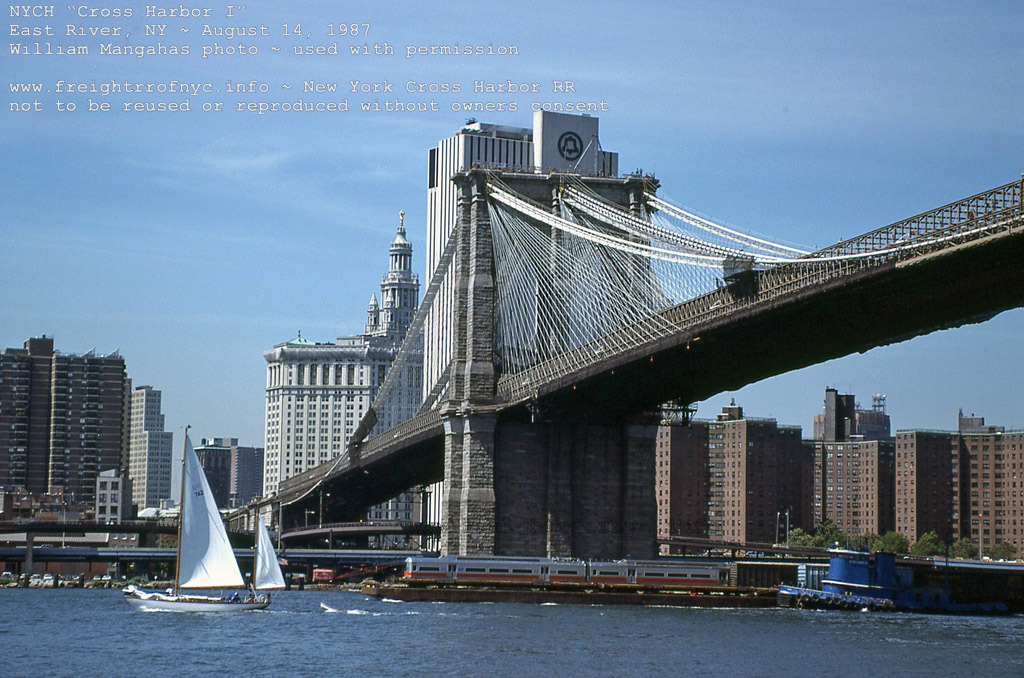 East River, NY - August 14, 1987
MetroNorth Commuter Railroad M-4's enroute to New York Railcar at Brooklyn Army Terminal for rebuilding. William Mangahas photo added 19 April 2021 |
| .
. |
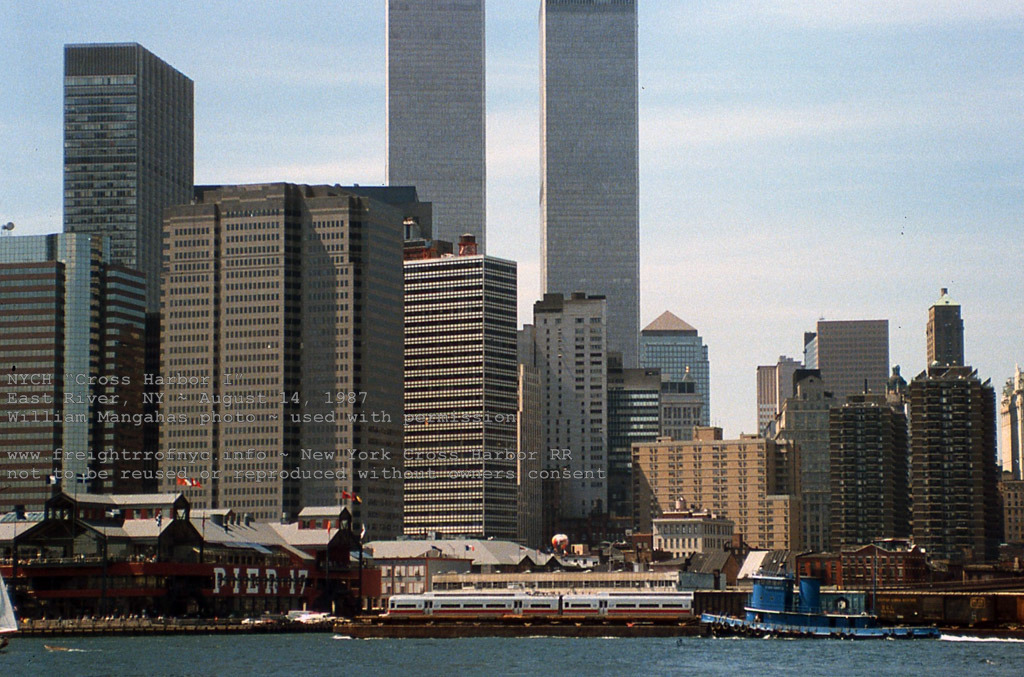 East River, NY - August 14, 1987
MetroNorth Commuter Railroad M-4's enroute to New York Railcar at Brooklyn Army Terminal for rebuilding. William Mangahas photo added 19 April 2021 |
| .
. |
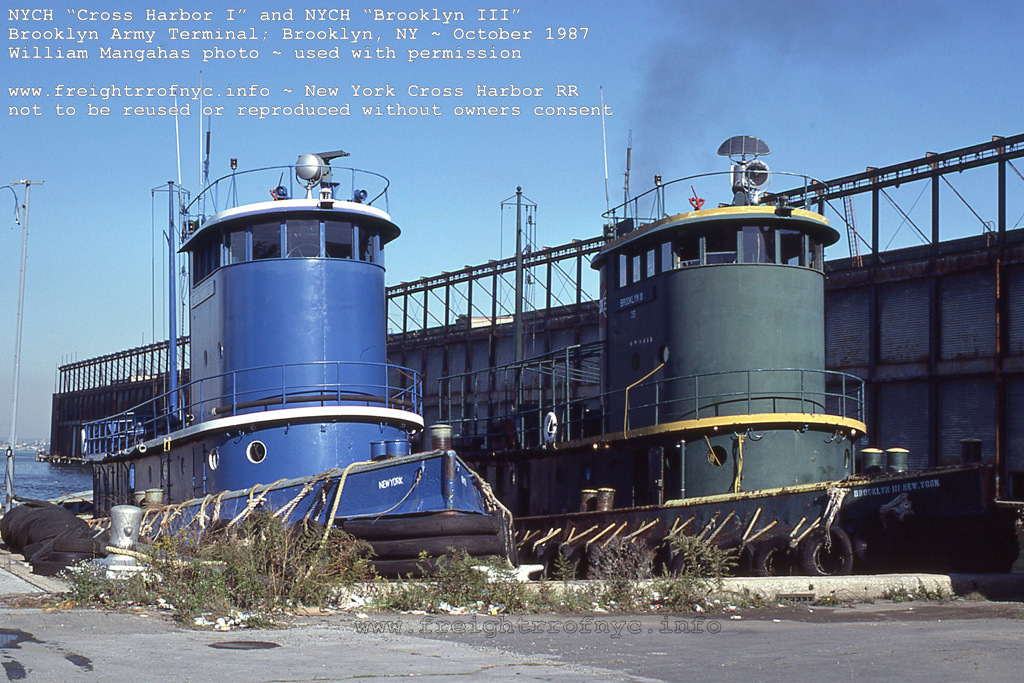 Brooklyn Army Terminal, Brooklyn, NY - October 1987
William Mangahas photo added 19 April 2021 |
| .
. |
|
|
| .
. |
| "Brooklyn III" |
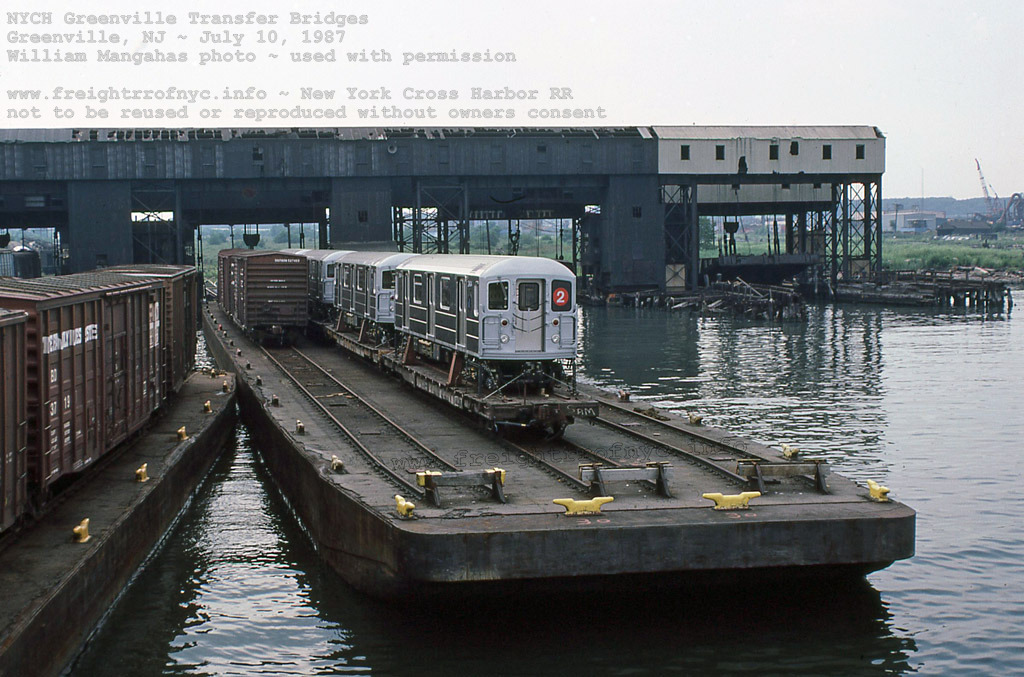 Carfloat #30 at Greenville Transfer Bridges, Greenville, NJ - July 10, 1987
new Bombardier R62's arriving. William Mangahas photo added 19 April 2021 |
| .
. |
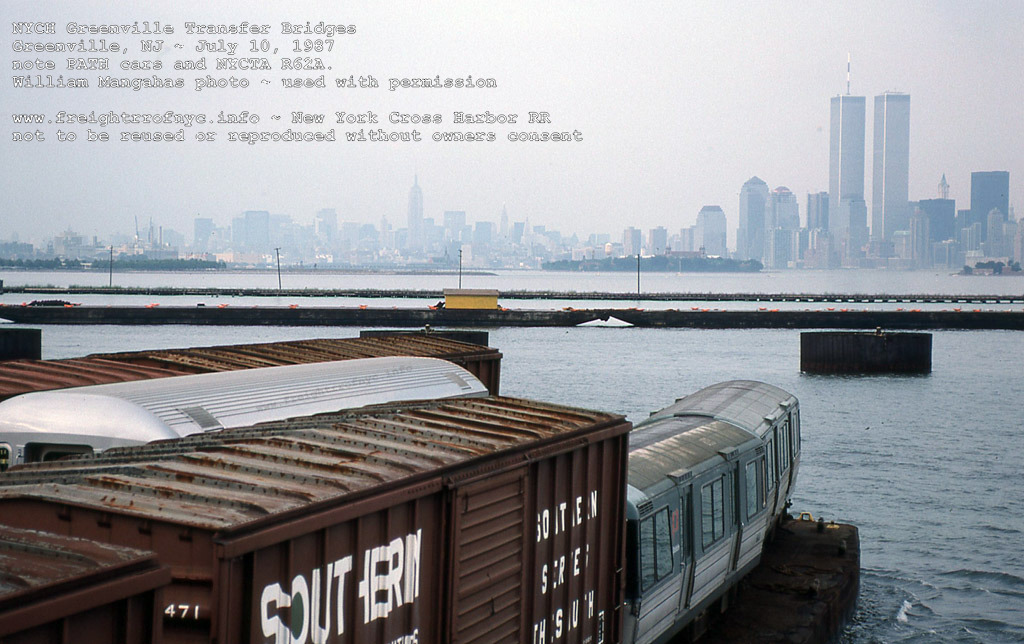 Greenville Transfer Bridges, Greenville, NJ - July 10, 1987
new Bombardier R62A's arriving, with PATH PA-2 cars being brought to the New York Railcar (a railcar rebuilder) at Brooklyn Army Terminal. William Mangahas photo added 19 April 2021 |
| .
. |
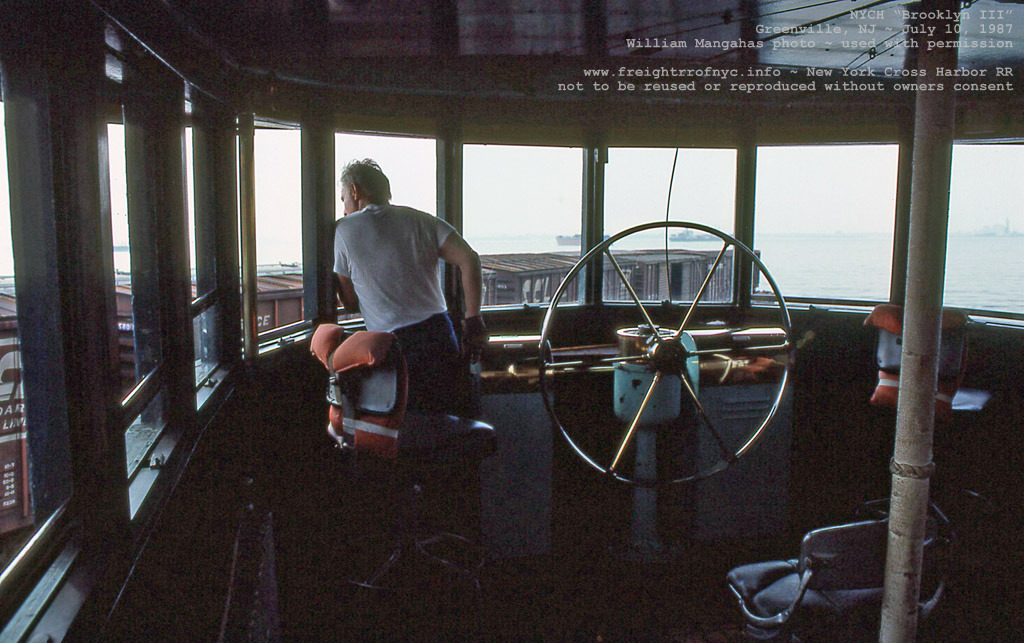 Greenville Transfer Bridges, Greenville, NJ - July 10, 1987
William Mangahas photo added 19 April 2021 |
| .
. |
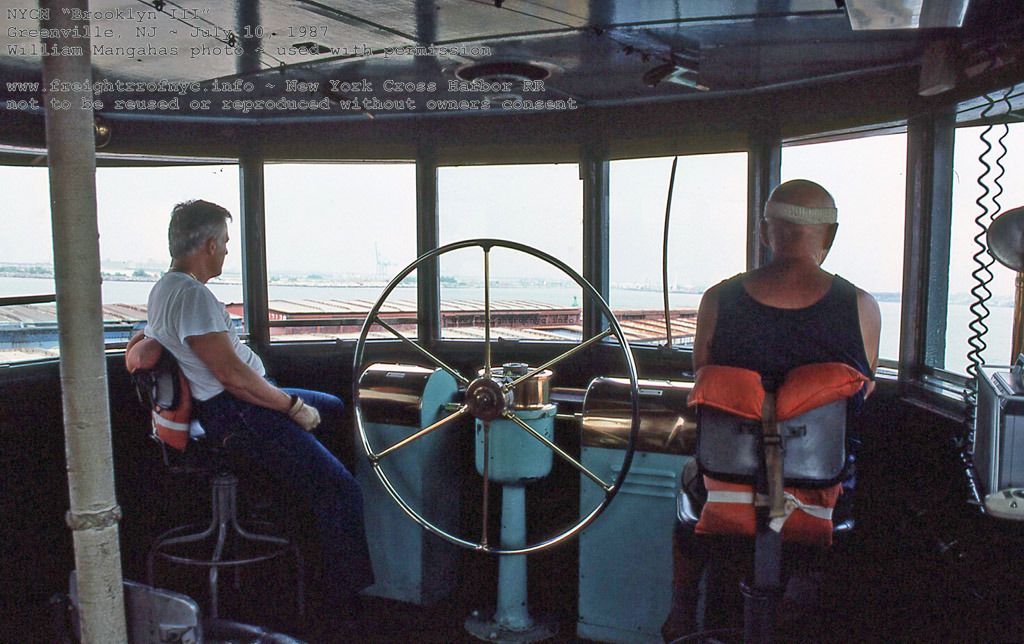 Greenville Transfer Bridges, Greenville, NJ - July 10, 1987
William Mangahas photo added 19 April 2021 |
| .
. |
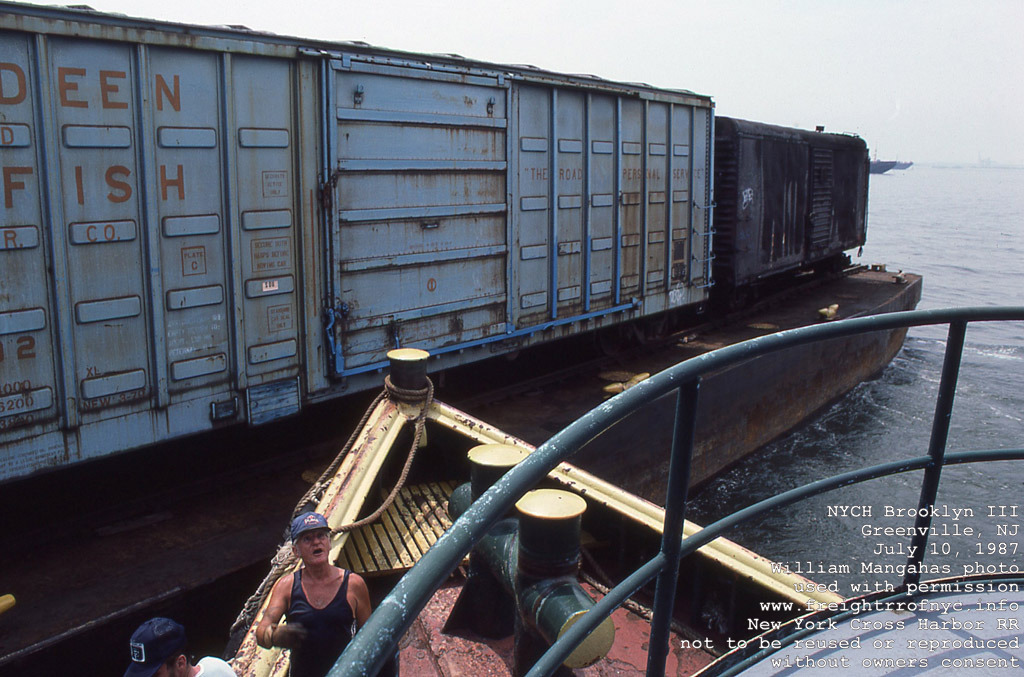 Greenville Transfer Bridges, Greenville, NJ - July 10, 1987
William Mangahas photo added 19 April 2021 |
| .
. |
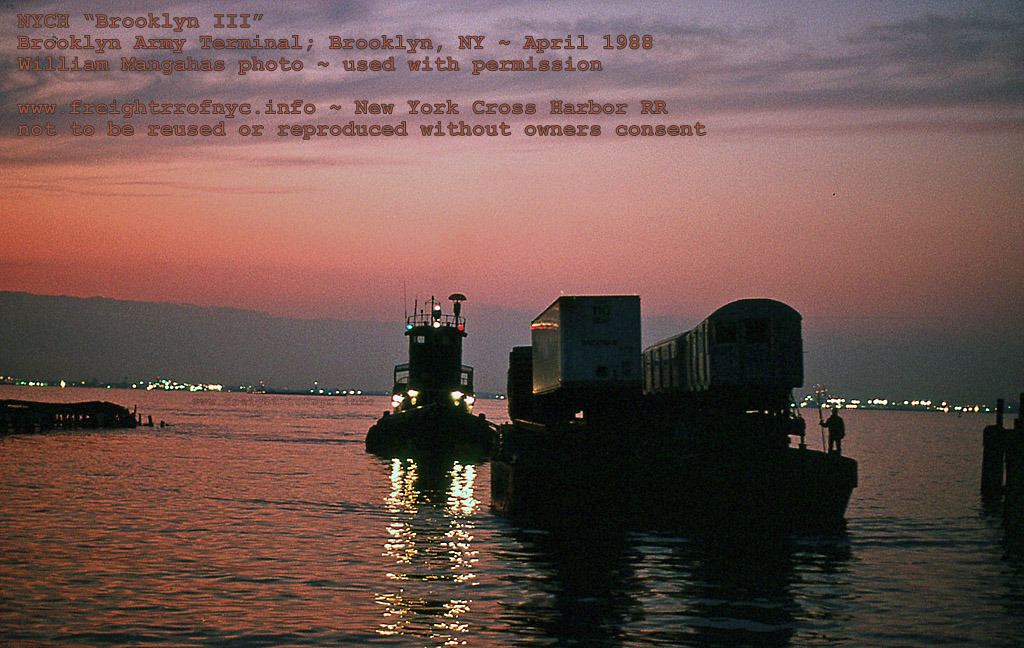 Brooklyn Army Terminal, Brooklyn, NY - April 1988
William Mangahas photo added 19 April 2021 |
| .
. |
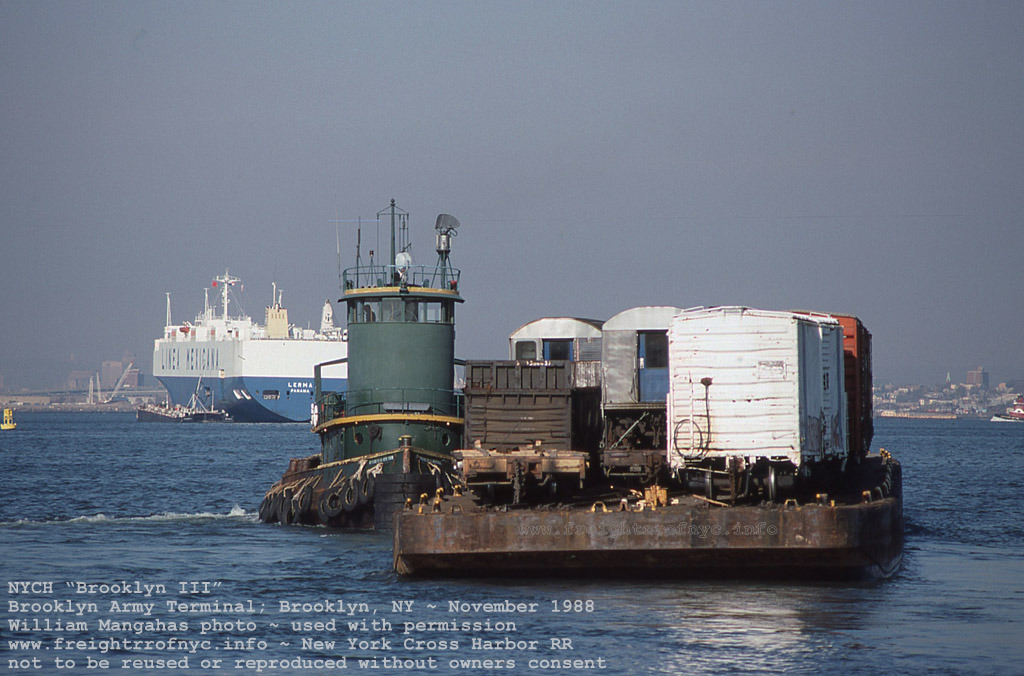
Brooklyn Army Terminal, Brooklyn, NY - November 1988
NYCTA BMT R-32's outbound for rebuilding. William Mangahas photo added 19 April 2021 |
| .
. |
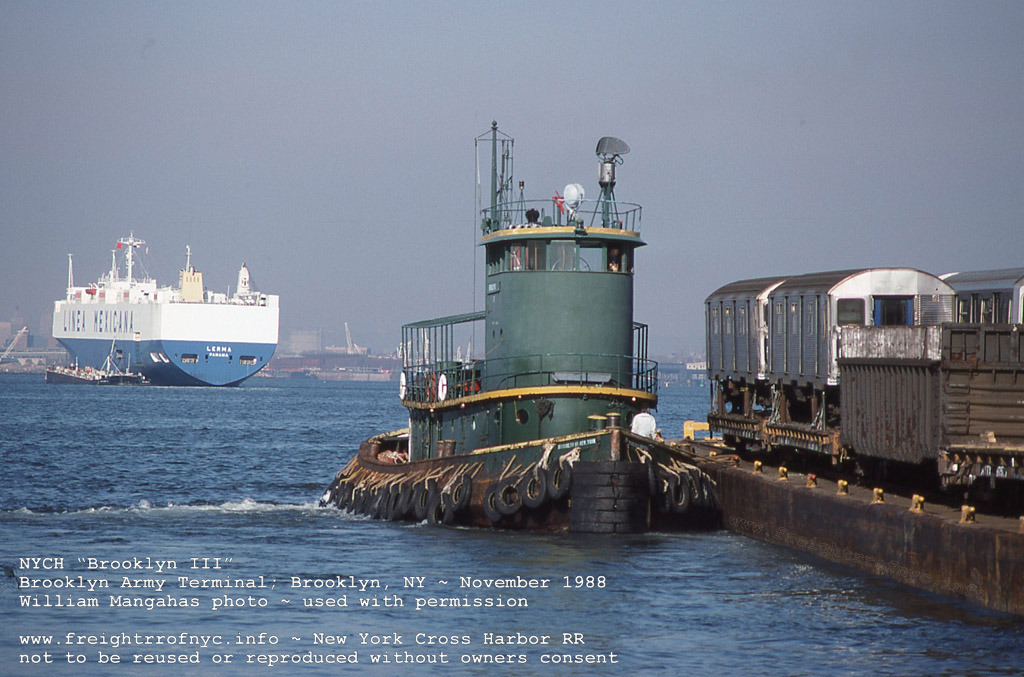
Brooklyn Army Terminal, Brooklyn, NY - November 1988
NYCTA BMT R-32's outbound for rebuilding. William Mangahas photo added 19 April 2021 |
| .
. |
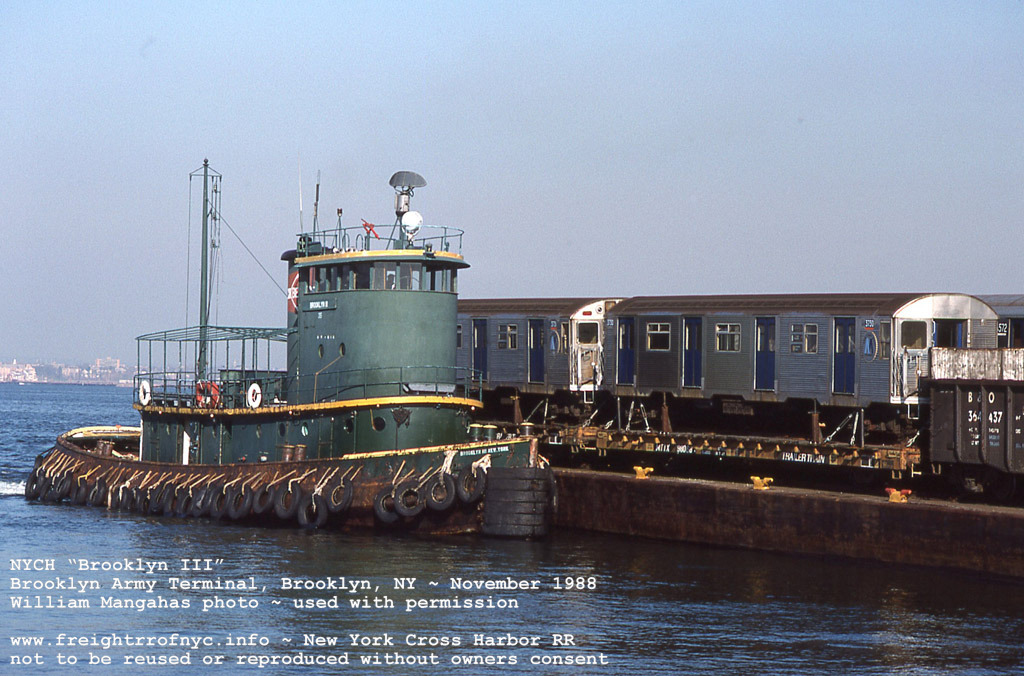 Brooklyn Army Terminal, Brooklyn, NY - November 1988
NYCTA BMT R-32's outbound for rebuilding. William Mangahas photo added 19 April 2021 |
| .
. |
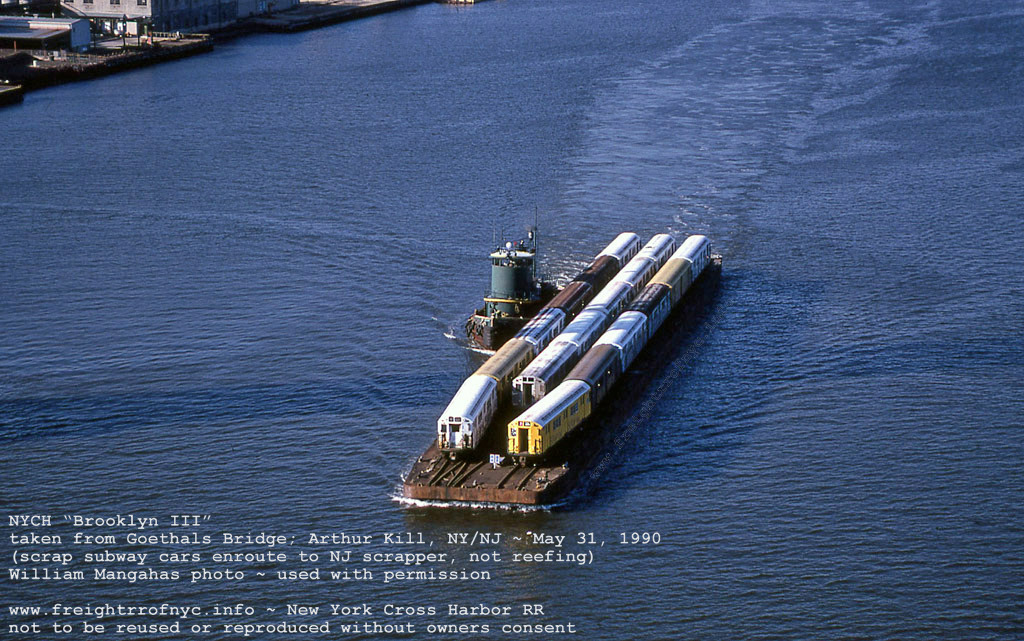 Arthur Kill, NY / NJ - May 31, 1990
Taken from the Goethals Bridge. NYCTA IRT R17, R21, R22 subway cars enroute to a scrapper (name?) located on Raritan River, NJ. These were not the subway cars that were "reefed". William Mangahas photo added 19 April 2021 |
| .
. |
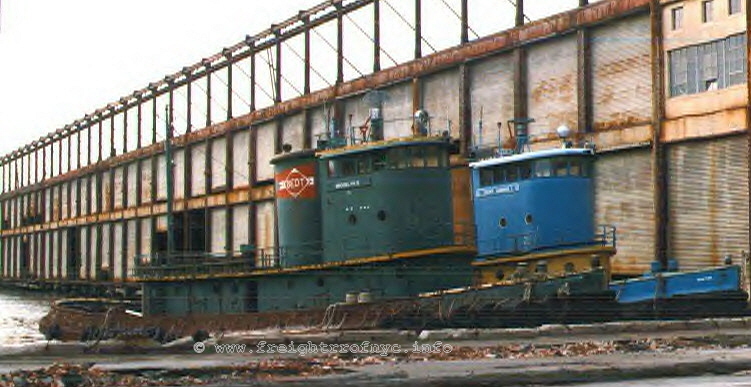 "Brooklyn III" and "Cross Harbor I" - unknown date At Brooklyn Army Terminal near the end of their days in Brooklyn. John McCluskey photo |
| .
. |
|
|
| .
. |
|
|
| .
. |
| At this point, New York Cross Harbor relinquished ownership of vessels and operation of a marine department, and outsourced carfloat towing to commerical marine towing companies. |
| .
. |
| Hepburn Marine "Pegasus" |
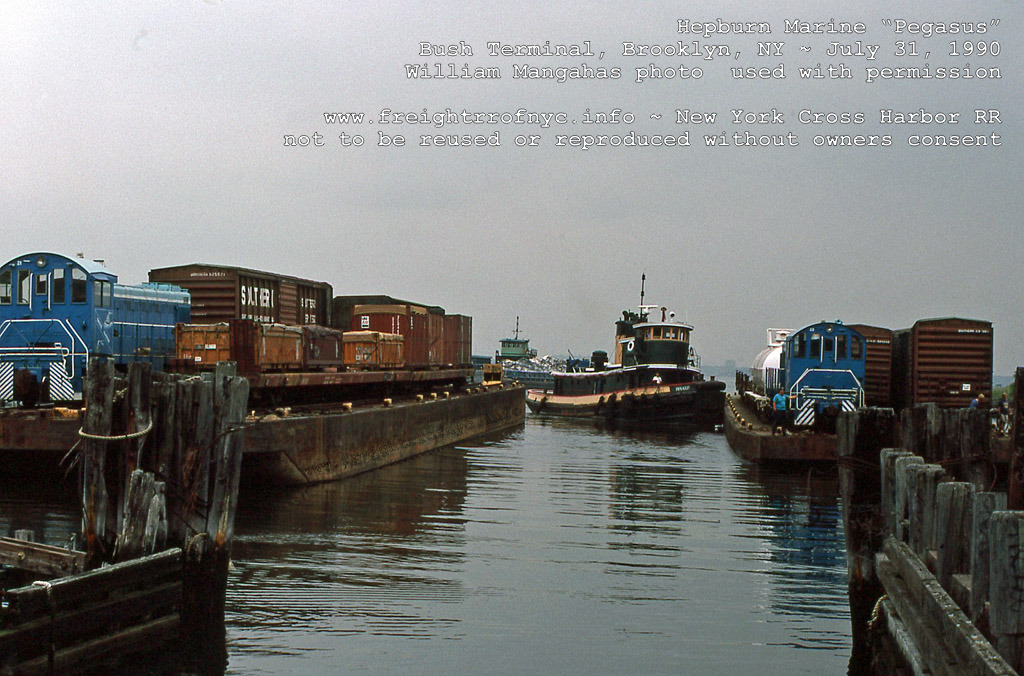 Hepburn Marine "Pegasus" at Bush Terminal Transfer Bridge, Brooklyn, NY - July 31, 1990
William Mangahas photo added 19 April 2021 |
| .
. |
| DonJon Marine "James M. Witte" This entry is interesting as the James M. Witte was a originally built as a railroad tug, the Central Railroad of New Jersey "Liberty", in 1953. She became the Baltimore & Ohio Railroads' "J. W. Philipps" in 1956. In 1964 she was acquired by Hampton Road Shipdocking (also known as Chessie Shipdocking); in Norfolk, VA and renamed the "M. I.Dunn". This vessel was sold again 1984 to DonJon Marine of Hillside, NJ, brought back to New York Harbor area and was renamed the "James M. Witte". So, at this point in her life, she is doing what she was originally built to do - move carfloats around New York Harbor! |
|
|
| .
. |
|
|
| .
. |
| Eklof "Algonquin" |
|
|
| .
. |
| Thomas J. Brown "John P. Brown" |
|
|
.
.
New York Cross Harbor Railroad Marine Vessel Roster
| vessel name |
builder |
build date |
hull number |
hp |
previous |
acquired |
disposition |
notes |
| Brooklyn III | Jakobson Shipyard Oyster Bay, NY |
1953 | 344 | 1590 | ex-NYNH&H "Cordelia" ex-NYNH&H "Transfer 23" ex-BEDT "Petro-Arrow" ex-BEDT "Williamsburgh" |
used 1983 from BEDT |
canopy removed ca. 1991 released back to NYCH scrapped 1996 |
wore BEDT livery entire career |
| Cross Harbor I | Jakobson Shipyard Oyster Bay, NY |
1953 | 345 | 1590 | ex-NYNH&H "Bumblebee" ex-NYNH&H "Transfer 24" ex-BEDT "Petro-Flame" ex-BEDT "Greenpoint" ex-BEDT "New Jersey" |
used 1983 from BEDT |
painting NYCH blue 1986; sold 1998 to Eastern Towing; for sale as of 2005; sold 2007 to Rhode Island Yacht Club to be used as a breakwater sunk 11/2007 in storm, future uncertain. |
originally the NYCH "New Jersey" until 1985. |
Tugboat Footnotes:
Apparently these two tugboats were owned by the Port Authority of New York and New Jersey and leased to New York Cross Harbor Railroad. More research is required in this area and is ongoing. Anyone with information is invited to contact me at: bedt14@aol.com
Carfloats:
The New York Cross Harbor Railroad utilized four carfloats in its operation. As constructed, carfloats can range from 200 to 350 feet long and each carfloat can hold between 10 to 15 cars, depending on the car lengths and loads.
An interesting side note is that New York Cross Harbor Railroad Carfloat #29 was involved in a lawsuit between New York Cross Harbor Railroad and their insurance underwriter in 1987, when #29 sank with its compliment of 15 loaded cars in the Brooklyn Army Terminal.
This carfloat has since been refloated and is still in service today.
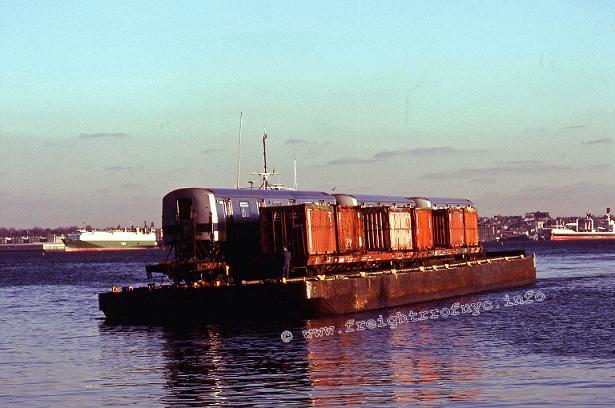
Greenville, NJ - November 30, 1990
A New York Cross Harbor Railroad carfloat (presumed to be either #16 or
#17)
with rebuilt subway cars and New York Cross Harbor Railroad flatcars.
Carl G. Perelman photo
New York Cross Harbor Railroad Carfloat Roster
| number | configuration | official and/or construction # | shipyard | hull laid | launched | info | notes | ref. |
| #16 | three track interchange | Bethlehem Steel | 1957 | steel hull 290' L x 41' W |
ex-New York Dock purchased from New York Dock Properties 8/1983 rehabilitated in 1998 with new rail. refurbished in 2009. Transferred to NYNJ Rail. |
|||
| . |
||||||||
| #17 | three track interchange | Bethlehem Steel | 1957 | steel hull 290' L x 41' W |
ex-New York Dock purchased from New York Dock Properties 8/1983 rehabilitated in 1998 with new rail. refurbished in 2009. Disposition unknown. |
[1] | ||
| . |
||||||||
| #29 | three track interchange | steel hull 360' L x 41' W |
ex-New York, New Haven & Hartford purchased from New York Dock Properties 8/1983 sunk 1987, refloated completely overhauled in 1999. Transferred to NYNJ Rail. |
|||||
| . |
||||||||
| #30 | three track interchange | steel hull 360' L x 41' W |
ex-New York, New Haven & Hartford purchased from New York Dock Properties 8/1983 sunk January 8, 2006 at Pier 7 Brooklyn. |
[2] | ||||
| . |
||||||||
| #25 | station / platform | ex-Brooklyn Eastern District Terminal leased 8/1983 from New York Dock Properties, returned |
||||||
| . |
||||||||
| #28 | ? | ex-Brooklyn Eastern District Terminal leased 8/1983 from New York Dock Properties, returned |
||||||
| 72 | ex- New York, New Haven & Hartford? leased 8/1983 from New York Dock Properties, returned |
|||||||
| 207 | ex-Baltimore & Ohio leased 8/1983 from New York Dock Properties, returned |
|||||||
Carfloat Footnotes:
|
[1] |
Carfloat #17 had its original "box style" track bumpers removed, and a "railroad tie" style bumper installed in place across each track. Removing the box style bumper yielded a few extra feet of track and this modification allowed accomodation of one extra MSW (municipal solid waste) car to feet on each track, thereby increasing the car capacity of the carfloat. (BJS) |
|
[2] |
Carfloat #30 after sinking on 1/2006, was salvaged by DonJon Marine Salvage Co. for a cost of $397,000. The carfloat was successfully raised on May 3 2006, and sold for scrap value to DonJon for $60,000. |
.
.
.
The New York Cross Harbor Railroad also came to own several of other pieces of various non-revenue equipment, as listed below:
MOW #3 Boxcar
This was an ex-Pennsylvania Railroad X-31 round roof boxcar and this car was used for general storage, Maintenance of Way service and as fuel storage by the New York Cross Harbor Railroad. Inside, a workbench, a hanging winch, 55 gallon drums and a large diesel generator were installed.
This car was landlocked on the #12 bridge lead in Greenville, NJ. A number 3 was painted on it in the New York Cross Harbor blue and teal, although it became heavily covered in graffiti.
This boxcar was scrapped in 2006 (believed to be July 2006).
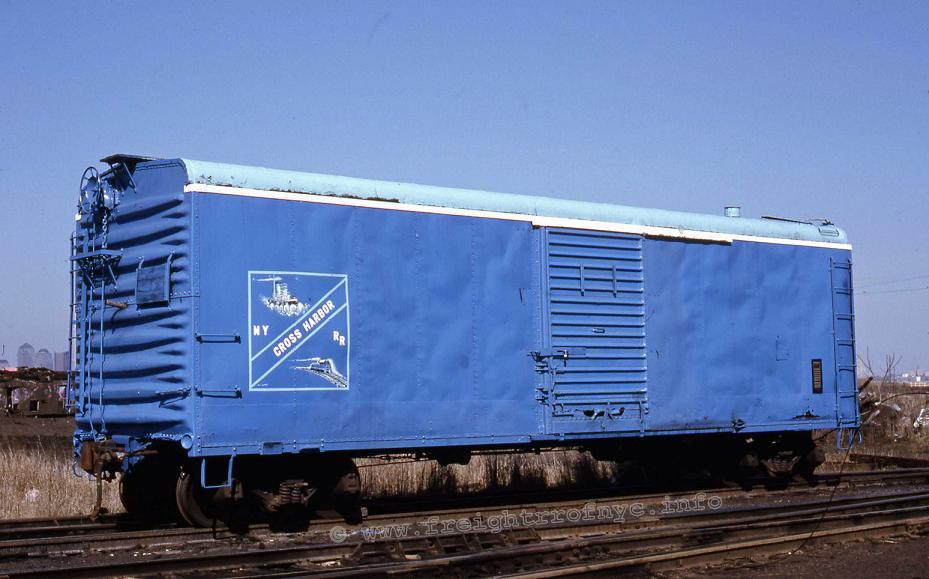
April 19, 1990
A.Tillotson photo
P. F. Strubeck
collection
added 02 May 2012
.
.
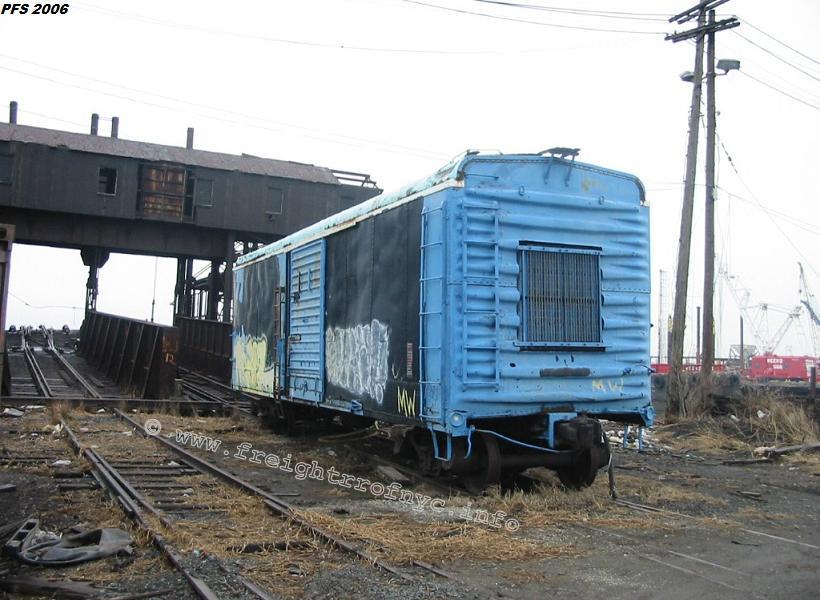

Greenville, NJ - March 2006
P. F. Strubeck photos
.
.
BEDT Bicentennial Boxcar
Inherited from the Brooklyn Eastern District Terminal. The origins of this car are not known. It had been painted red, white and blue by Brooklyn Eastern District Terminal shops in 1976 for the Bicentennial Celebration of the United States and for Operation Sail..
The New York Cross Harbor Railroad had this car in ownership from August 1983 until at least 1997. During this time, it was used for storage in Greenville, NJ. This car also had holding tanks for diesel fuel for the locomotives which were gravity fed.
The disposition of this car is unknown and is presumed scrapped:
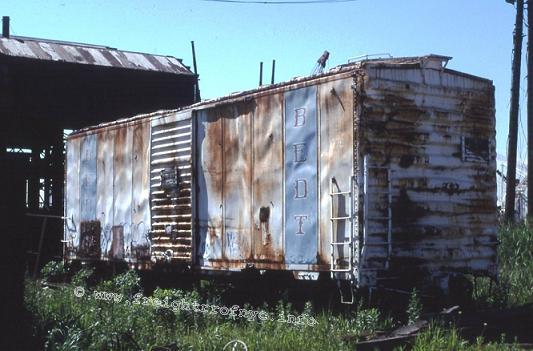
Greenville, NJ - 1997
John McCluskey photo
.
.
N5 Class Caboose - Yard Office
The New York Cross Harbor Railroad and now New York New Jersey Rail has a caboose, which was used as a Yard Office at Bush Terminal but is now vacant. It was originally a Pennsylvania Railroad N5 class caboose.
Careful examination by both this author and fellow historian Philip M. Goldstein in July 2007 and again in February 2009 has revealed that this caboose has a layer of red paint and then green paint under the current blue paint. Therefore, this caboose is in all likelihood the caboose formerly used as the master mechanics office of the Brooklyn Eastern District Terminal, and of which was located behind the enginehouse and shops of that railroad at North 8th Street and the East River Bulkhead.
Information received from Benjamin W. Schaeffer, clarifies the
history:
This was the third of three cabooses purchased by New York Dock
circa 1968. This caboose which went to BEDT is understood to have suffered
a minor fire. During tenure at New York Dock, it is unknown if used.
If one takes notice, the caboose is first seen at BEDT in the same dark "New
York Dock green" with black roof and yellow rungs as C58 above. Due to this,
and according to anecdotal information supplied to Benjamin W. Schaeffer,
this caboose is almost certainly to have been from the NYD group of three
cabooses. In 1980, (following the BEDT / NYD merger in 1978), the caboose
was sent to Bush Term enginehouse and repainted green with large triangle
NYD logo. It was then moved to the First Avenue entrance gate at the
Brooklyn Army Terminal and used as an office for the Trailer on Flatcar (TOFC)
operation. Upon cessation of this service, caboose was then moved to back
(south end) of Brooklyn Army Terminal property at the south end of the buildings.
Circa 1986 New York Cross painted out NYD logo in green, moved caboose
to south side of 65th Street Yard. Subsequently moved again to Bush Terminal
enginehouse, repainted blue and Cross Harbor herald (type two) on one side
only (facing First Avenue) and moved to Greenville to be used as office
for TOFC bogie operation. Moved back to Bush Terminal following cessation
of bogie operation and unused. The FBI used the caboose for an undercover
sting operation circa 1992. In 1993, the caboose was used on a railfan day
photo shoot at end of train. In 1994, made into office for Safety Kleen
Corp. Porch and bar-b-que pit believed to have been added at this time.
Used until ca. 1996 and then vacated. Currently stored at Bush Terminal on
and property of New York New Jersey Rail.
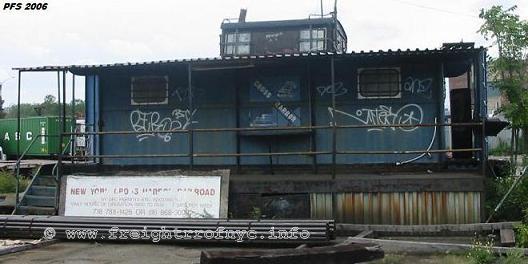
(east side - facing First Avenue)
.
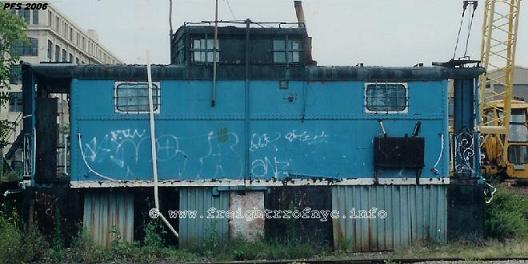
(west side - facing warehouses)
New York Cross Harbor Railroad Caboose / Office, Bush
Terminal Yard - September 2006
P. F. Strubeck photos
.
.
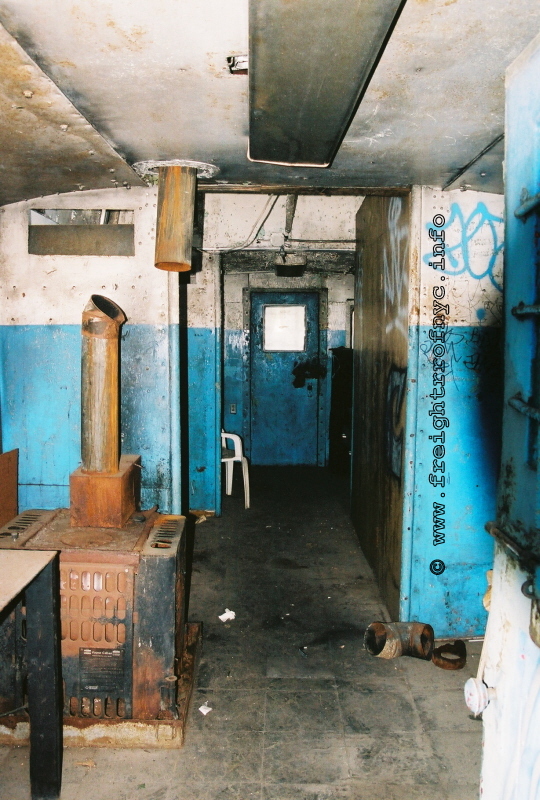
New York Cross Harbor Railroad Caboose / Office - June
28, 2008
P. M. Goldstein photo
.
.
New York Dock Caboose:
The New York Cross Harbor Railroad also acquired this caboose as well in 1983. It was painted blue and was heavily covered in graffiti in 1995. It was painted in red primer and sat on the First Avenue track for awhile.
This caboose might have been the Bush Terminal Railroad's Yard Office which was located at 50th Street and First Avenue at the base of the coal silo. Images of the caboose show it was numbered C31. However, this is unconfirmed at this time.
Disposition is unknown and presumably scrapped.
LIRR C-70 Caboose
This caboose was stored in Bush Terminal for a period of time, and would eventually be towed to Gershow Recycling and scrapped.
It is not confirmed at this time if in fact it was even owned by New York Cross Harbor Railroad.
89' Flatcars
In 1988 through 1991 (?), the New York Cross Harbor Railroad leased their own fleet of flat cars. These were leased from ITEL Rail Corporation by Interstate BiModal Inc on behalf of New York Cross Harbor Railroad. These cars were former Canadian Pacific Railway 89' 4" Trailer On Flat Car (TOFC) flatcars and The cars were numbered 89100-89199.
They were equipped to move three 20' containers. It appears that these were also used for the short move of liquid sugar done dockside.
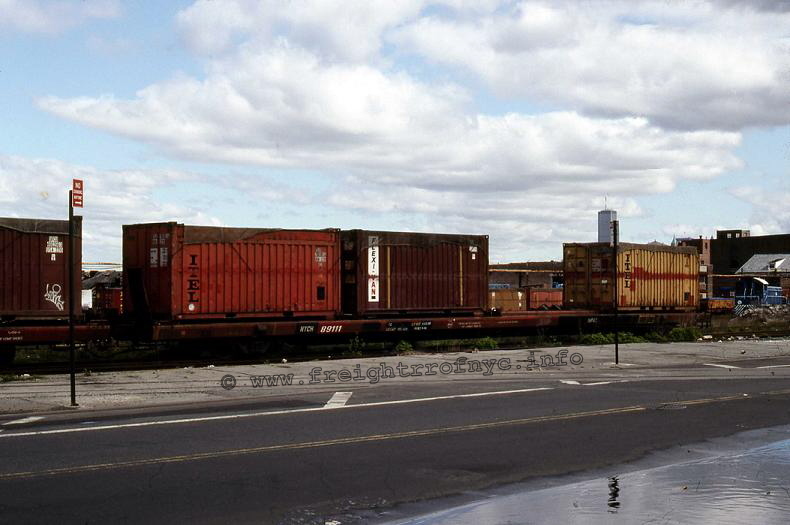
New York Cross Harbor #89111 - May 6, 1990 - Bush Terminal
/ First Avenue Yard
Loaded with 20' containers of municipal waste.
R. Montag photo
P. F. Strubeck
collection
added 02 May 2012
.
.
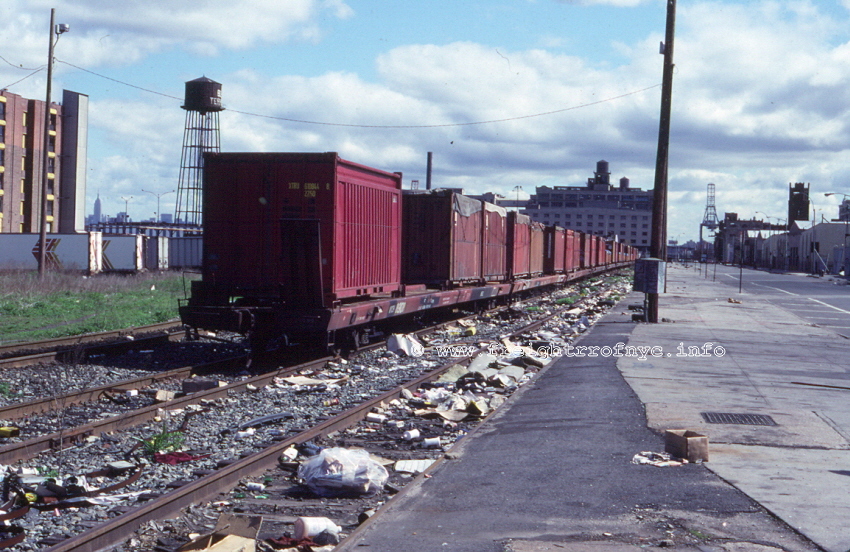
New York Cross Harbor #89108 - May 6, 1990 - Bush Terminal
/ First Avenue Yard
Loaded with 20' containers of municipal waste.
R. Montag photo
P. F. Strubeck
collection
added 06 March 2012
.
.
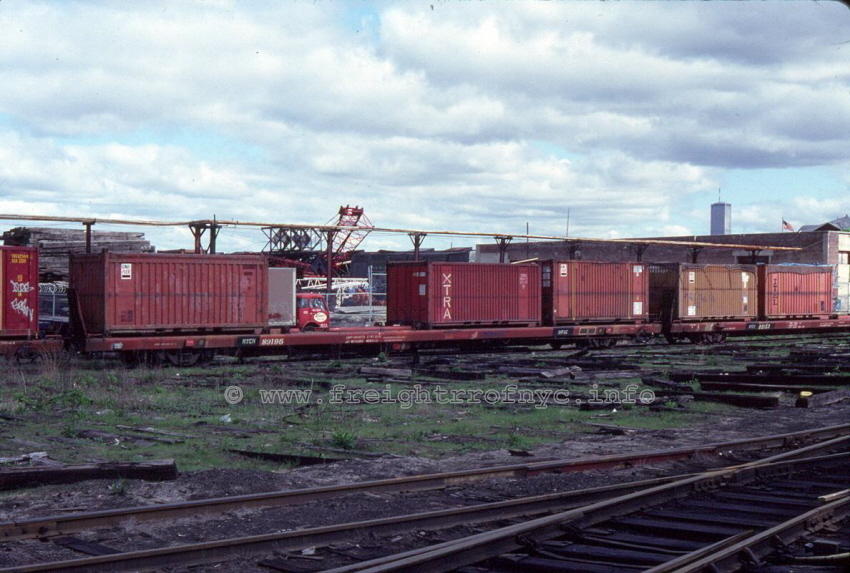
New York Cross Harbor #89195 - May 6, 1990 - Bush Terminal
/ First Avenue Yard
Loaded with 20' containers of municipal waste.
R. Montag photo
P. F. Strubeck
collection
added 14 October 2012
Disposition of these flatcars is unknown, but it is presumed that they have been returned to lessor.
NYCTA Flatcars
In 1997, the New York Cross Harbor Railroad acquired a pair of ex-New York City Transit Authority flatcars to use as rail & tie cars.
These cars were located in Greenville, New Jersey until March 2006, it is assumed they were scrapped.
Conrail Gondola #539891
Conrail gondola #539891 was an old beat up and battered 50' gondola that New York Cross Harbor Railroad used through the 1980's as a carfloat reacher car.
#529891 had friction bearing trucks and was severely deteriorated. Its disposition is unknown and it is presumably scrapped.
New York Cross Harbor Gondola #58172
This was a former Western Maryland 50' gondola. Referencing other online archival sites, the 58000 series numbering corresponded to the Western Maryland gondola numbering as well.
The disposition of this gondola is unknown.
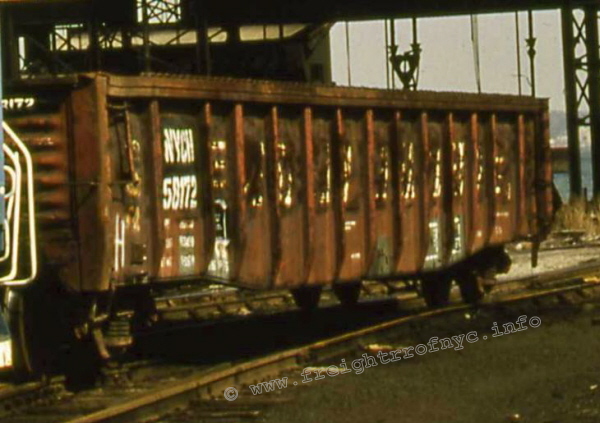
Greenville, NJ - April 14, 1994
C. Perelman photo
P. F. Strubeck
collection
added 03 April 2011
.
.
New York Dock Idler Car 101
#101 was another idler car used by New York Cross Harbor Railroad in the 1980's.
#101 was acquired from New York Dock, who in turn got it from Bush Terminal. This car was filled with rails for weight and was notched on the ends for ladders.
Information received from Fred Breimann, (retired Bush Terminal / New York Dock / New York Cross Harbor locomotive engineer) has it that this car was originally an outside braced high side gondola and modified by Bush Terminal.
It was last seen on its side in Greenville , New Jersey in 1997, and it has presumably been scrapped:
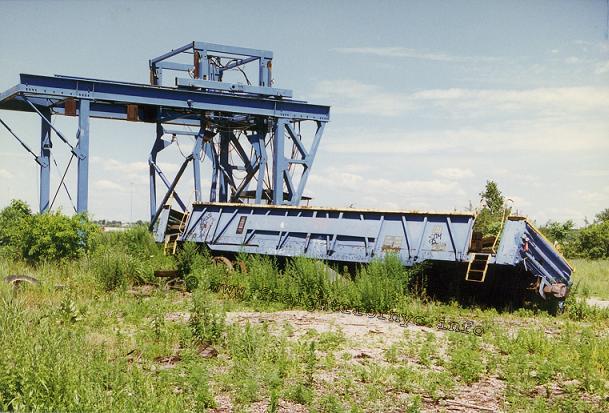
Greenville, NJ - 1997
That is one of the container cranes used in the experimental bogie service
behind the reacher car.
Both were presumably scrapped.
John Teichmoeller photo
.
.
Kalmar Container Crane
New York Cross Harbor Railroad acquired a Kalmar 42-1200 container loader for use at Bush Terminal for the loading of the sludge containers.
It was painted red and black and had "NYCHRR" painted on the side.
Disposition unknown.
Pick-up Truck
The New York Cross Harbor Railroad had an old Ford truck in the 1990's. It was painted blue and was equipped with a work body.
Disposition unknown.
.
Here is a chapter that has needed to have been composed for quite a while. Modeling!
If anyone has anything they would like to submit, please send it to bedt14@aol.com for inclusion
Prof Klyzlr Models
John was gracious enough to include articles about modeling the New York Cross Harbor Railroad locomotive #11, #25 and #59!
Please click the photos below to view each page (PDF format).
#11 #25 #59
Paul F. Strubeck models:
Tugs
Here is my model of the "Brooklyn III". It is a stock Walthers kit. However, I have removed some of the Lehigh Valley Railroad details from the model (of which was used as a prototype) and started to rework it to confirm to the Brooklyn III.
I will also be adding the canopy of course.
.
|
|
| .
. |
|
|
| .
. |
|
|
| .
. |
|
|
| .
. |
|
|
.
.
Like what you see? Suggestions?
Comments?
As this particular webpage deals with an active railroad, viewers should be aware that:
this webpage or the author is not affiliated with:
.
the New York City Transit Authority,
Metropolitan Transit Authority,
or the City of New York;
.
or any of their subsidieries, holding companies or parent organizations,
employees or otherwise;
and no affliation or connection with those companies or municipalities is
suggested or implied.
This website and the information contained
within has been compiled for the use of reference only, and any inaccuracies
are purely accidental.
This webpage sees revision for the purpose of the addition of information,
or correction of inaccurate data.
Suggestions or corrections should be sent directly
to:
crossharbor11@gmail.com